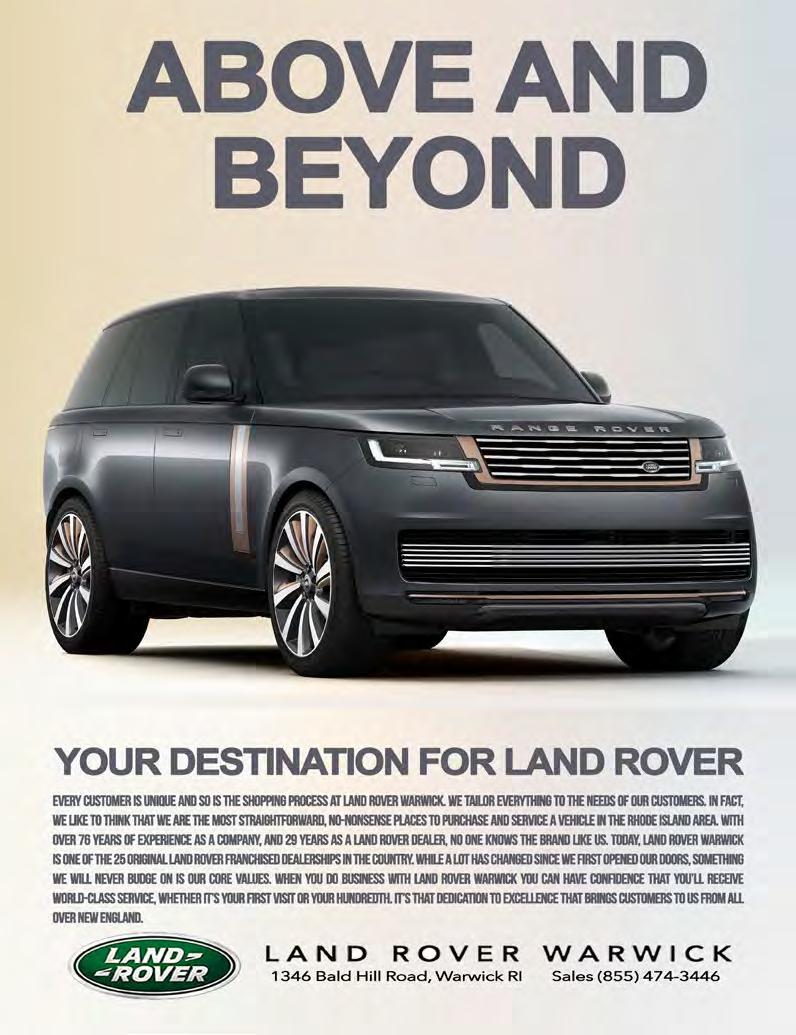









emorymotorsports.com • instagram.com/rodemory facebook.com/emorymotorsports














emorymotorsports.com • instagram.com/rodemory facebook.com/emorymotorsports



6 BR | 8 BA | 2 HALF BA
$6,499,000
At the end of a winding driveway with organic gardens and a striking multi-gable, black-aluminum roof sits this serene and secluded masterpiece. Built by a reputable developer in 2020, this home is the pinnacle of luxury and modern elegance. Some of the highlights include a dream chef’s kitchen, attached 3-car garage, and a custom-engineered, floating staircase seamlessly bridges all four levels. The finished lower level features a walkout to the backyard, offering additional living space and versatility. The breathtaking backyard, with its in-ground pool, detached cabana, grill house, fire pit, and multiple outdoor dining areas, is the perfect setting for entertaining.
| Web# 73254002





Herb Chambers Exotics is Now Taking Orders to Custom Build Your...

Most powerful GT ever built Twin-Turbo V8 PHEV - 771 HP 0-60 in 3.1 Seconds

Since 2004, we’ve been creating the automotive section for several regional newspapers. In 2020, we launched Automobiles Magazine, covering Massachusetts, Connecticut, and Rhode Island. Our content spans auto reviews, industry leader interviews, road tests, and vehicle comparisons, originally focused on new and highline pre-owned specials from leading franchised dealers. Delivered digitally each month, we’ve now expanded to a printed edition to keep readers connected with the latest automotive news and developments.
Print Edition Despite the prevalence of digital media, printed magazines remain cherished for their tangible appeal. Many readers appreciate the tactile experience of flipping through pages, enjoying high-quality visuals, and reading thoughtfully curated content that offers a reprieve from the constant digital barrage. Printed issues often become collectors’ items, offering a sense of permanence and credibility that digital media sometimes lacks. Our print edition will continue featuring in-depth reviews, timely news, and engaging ads, arriving at subscribers’ and advertisers’ doors about a week before the issue date.
Digital Edition Alongside our print publication, the digital version of Automobiles Magazine remains available in the second week of each cover month. It includes all the print content, along with exclusive new car specials from top franchised dealerships. The timing aligns with manufacturer incentives, typically released early in the month, allowing dealerships to finalize and publish their best offers. This ensures the digital edition brings readers the most up-to-date specials and promotions.
Distribution Sent out to over 100,000 higher income individuals across Rhode Island, Massachusetts, and Connecticut, our digital edition reaches a broad audience and is also accessible through the Automobiles.media website. This approach allows us to share timely dealer specials and maintain the depth and quality of content seen in our print version. We believe offering both formats gives readers the best experience— beautifully crafted print content paired with up-to-date digital information to assist in their automotive decisions.
Thank you for being part of our readership. We look forward to delivering the best in automotive journalism both online and in print.
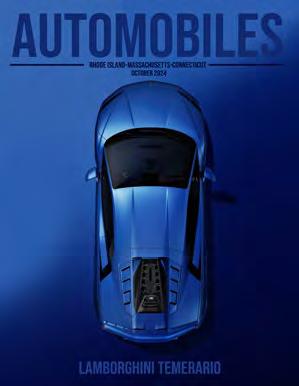



VERMONT’S GREEN MOUNTAIN BYWAY: A
62 ADVERTISING ANALYSIS: It’s Time to Ban Banner Planes for the Sake of Our Peace and the Environment
65 CHARGING AHEAD: How Rhode Island, Massachusetts, and Connecticut Compare to the Rest of the U.S.
68 NIKITA ZADOROV'S LATEST ACQUISITION: The Bentley Flying Spur Edition 8
70REVIEW: The Lamborghini Temerario, A New Benchmark in Supercars
72NICK BALDELLI’S FERRARI SATISFIES BOTH HIS FAMILY NEEDS AND AUTOMOTIVE PASSION
76 PASSINGS: The Chevrolet Camaro (1966–2024)
78 THE INTERESTING LEGACY OF ART CARS: From BMW to Independent Creators
80 THE HIDDEN COSTS OF CONVENIENCE: How Third-Party Auto Shopping Services Affect Your Deal
84 THE PECULIAR ECONOMICS OF PORSCHE 911 GT3 RS: How Used Models Command Higher Prices Than New Ones
87 HIGH LINE PRE-OWNED
91OCTOBER 2024 NEW VEHICLE SPECIALS
158 ELMWOOD AUTO BODY: A Legacy of Excellence in Auto Repair
161 AUTO BODY DIRECTORY
168 HOW TO INSURE CLASSIC CARS: What Enthusiasts Need to Know
170 SERVICE YOUR CAR BEFORE WINTER IN NEW ENGLAND
178 LIVING LARGE IN A TINY SPACE: Lessons from RV Dwellers By Brianna Jeane
182 RV REVIEW: Grand Design Lineage

2024 has proven to be a year of contrasts in the U.S. auto market, with some automakers experiencing significant growth while others struggle to maintain their foothold in an increasingly competitive landscape. A closer look at the data reveals the dynamic nature of the industry, highlighting both winners and losers in a market that remains a crucial pillar of the American economy.
Acura: Struggles Amidst Tough Competition
Acura, Honda’s luxury division, faced a challenging year, with a 13.1% decrease in sales.
The brand’s TLX sedan saw a significant 55.6% drop, while the MDX, a key model in Acura’s lineup, experienced a 19.6% decline. Despite these challenges, the RDX managed to post a 28.4% increase, driven by its strong appeal in the luxury SUV segment. The introduction of the ZDX electric model, with a 100% increase in its category, signals Acura’s efforts to reposition itself in the growing EV market.
Audi: Declining Sales Amidst a Competitive Landscape
Audi, part of the Volkswagen Group, experienced a 14.2% decline in sales in 2024, highlighting the pressures facing luxury brands in the current market.
Audi’s flagship A4/S4 models saw a steep 44.7% decline, while the Q7 SUV posted a 40.6% drop. These declines were partly offset by gains in the Q3 (up 60.5%) and the R8, which saw a 42.2% increase. Audi’s transition to electric vehicles showed mixed results, with the Q4 e-tron increasing by 9.3%, but the e-tron GT dropped by 22.0%.
Alfa Romeo: Modest Gains with Strong New Model Performance
Alfa Romeo, part of Stellantis, reported a 1.6% increase in overall sales, driven by the strong performance of its new Tonale model, which saw a 1,280.3% increase.
However, the brand’s traditional models, such as the Giulia and Stelvio, faced declines of 29.2% and 32.2%, respectively, reflecting the challenges of competing in the luxury sports sedan and SUV markets.
Aston Martin and BMW Group Lead Luxury Gains
Among the luxury brands, Aston Martin and BMW Group have posted notable increases. Aston Martin saw a remarkable 45% surge in sales across all models, with its lineup generating 990 units, up from 835 units in the previous year. Particularly strong performance was noted in Aston Martin’s more exclusive models, offsetting a slight decline in their truck segment, which saw an 11.2% drop.

BMW Group, a major player in the luxury segment, reported a modest overall increase of 1.5% in sales, with BMW-branded vehicles driving this growth with a 3.1% rise. The brand’s 2 Series saw a staggering 53.7% increase, while the X1 and X3 SUVs recorded gains of 61.3% and 24.7%, respectively. However, not all models fared well; the 4 Series and X6 experienced declines of 22.6% and 23.8%, reflecting shifting consumer preferences within the brand’s diverse lineup.
Mercedes-Benz, another stalwart in the luxury segment, faced a 4.6% decline in sales, indicative of the broader challenges facing traditional luxury brands in the transition to electric vehicles. While the introduction of the CLE model brought a 100% increase in sales, other segments did not perform as well. The EQS, a flagship electric model, saw a sharp 59.1% decrease, while its SUV counterpart dropped by 48.4%. These declines underscore the brand’s ongoing struggles to find its footing in the EV market, despite strong performances from models like the GLC, which posted a 28% increase.
Among mainstream automakers, the story was similarly mixed. Ford Motor Co. saw an overall sales increase of 3.8%, with standout performances from models like the Maverick, which surged

81.4%, and the Mustang Mach-E, which rose by 58.4%. However, the iconic F-Series trucks, long a staple of the brand, experienced an 8% decline, raising questions about the future of traditional trucks in a market increasingly dominated by electrification and alternative fuels.
Fiat Chrysler Automobiles (FCA) experienced a 15.5% decrease in overall sales, driven by declines across several key models. The Ram pickup line, a critical component of FCA’s portfolio, saw a 19.5% drop, while the Jeep Grand Cherokee and Dodge Charger posted declines of 14.6% and 42.5%, respectively. Despite these challenges, the introduction of new models like the Hornet helped mitigate some losses, with the model contributing a 347.4% increase in its segment.
General Motors Co. (GM) reported a slight decrease of 0.5% in total sales. The company’s performance was bolstered by the strong sales of the Chevrolet Silverado, which increased by 4.4%, and the resurgence of the Trax, which saw a 230.3% increase. However, declines in the Suburban (29.8%) and Traverse (39.6%) indicated difficulties in the large SUV segment.
Hyundai: Hyundai saw a modest 1.2% increase in sales, driven by strong performances from models like the Palisade, which posted a 36.3% increase, and the Ioniq 5, which saw a 37.3% rise. The Kona also performed well, with a 22.7% increase. However, several models experienced declines, including the Tucson (down 8.4%) and the Santa Fe (down 7.4%), highlighting the competitive pressures in the SUV market.
Toyota Motor Corp. was one of the year’s biggest winners, with a 14.3% increase in sales. The brand’s robust performance was driven by the success of the RAV4, which posted a 32.8% increase, and the newly introduced Grand Highlander, which saw a remarkable 34,731.4% increase as it entered the market. The Tacoma and Highlander models, however, struggled, with declines of 40.6% and 46.9%, respectively, reflecting a shift in consumer preferences towards more fuel-efficient and hybrid models.
Tesla Motors Inc. reported a 5.2% decline in overall sales, reflecting a challenging year for the electric vehicle pioneer. While the Model Y remained a strong performer with an 11.5% increase, other models like the Model 3 and Model S experienced significant declines of 39.2% and 48.1%, respectively. The launch of the Cybertruck provided a bright spot with 8,500 units sold, but the broader slowdown raises questions about Tesla’s ability to maintain its dominant position as traditional automakers continue to expand their electric offerings.
Volkswagen Group posted a 7.0% increase in sales, driven by strong performances from its Atlas and Tiguan models, which saw increases of 39.8% and 10.0%, respectively. The ID.4, however, saw a 27.9% decline, highlighting the challenges faced by legacy automakers in the electric vehicle market. Audi, a subsidiary of Volkswagen, experienced a 14.2% decline, with notable drops in sales of the A4/S4 (44.7%) and Q7 (40.6%).
Hyundai-Kia Automotive, a major player in the U.S. market, reported a slight overall decrease in sales of 0.3%, reflecting the mixed results across its diverse lineup.
Kia: Kia, on the other hand, reported a 2.0% decline in sales. While the brand’s EV6 and new EV9 models showed promising growth, with increases of 31.4% and 100%, respectively, several other models struggled. The K5 saw a significant 58.5% drop, and the Rio experienced a steep 86.5% decline. Despite these challenges, Kia’s Sportage and Forte models provided some relief with gains of 11.1% and 13.6%, respectively.
Volvo: Steady Performance with a Focus on EVs
Volvo Cars N.A. reported a 2.1% increase in sales for 2024, reflecting the brand’s steady performance in a competitive market.
The XC40 and XC90, two of Volvo’s most popular models, posted gains of 5.9% and 2.8%, respectively. However, the brand’s electric
models, such as the C40, saw significant declines, with the C40 dropping by 86.4%. This mixed performance underscores the ongoing challenges and opportunities in the electric vehicle market as Volvo continues its push towards electrification.
Cadillac: Struggling with Sedans, Success with Electric Models
Cadillac, General Motors’ luxury brand, reported a 1.7% decrease in sales for 2024, reflecting the ongoing shift in consumer preferences away from traditional sedans.
The CT4 and CT5 sedans saw significant declines of 35.6% and 31.3%, respectively. However, Cadillac’s electric offerings showed strong performance, with the Lyriq posting a 465.4% increase, signaling the brand’s successful entry into the EV market. The Escalade, a key model for Cadillac, saw a 7.6% decline, although it remains a strong player in the luxury SUV segment.
Lexus: Steady Growth in a Competitive Luxury Market
Lexus, Toyota’s luxury division, reported an 11.9% increase in sales, making it one of the betterperforming luxury brands in 2024.
The RX, Lexus’ best-selling model, saw a 4.2% decline, while the NX posted a modest 1.8% increase. The introduction of the TX model, which recorded a 100% increase, and the strong performance of the RZ (up 404.8%) and the ES sedan (up 1.2%) contributed to the brand’s overall growth. Despite these gains, Lexus faced challenges with models like the GX, which saw a 31.4% decline, indicating the brand’s mixed fortunes in the competitive luxury market.
Mini: Struggles in a Changing Market
Mini, part of the BMW Group, experienced a 17.5% decline in sales, reflecting the challenges of maintaining relevance in a market increasingly dominated by SUVs and crossovers.
The Cooper S saw an 18.1% decline, while the Countryman posted a 16.4% drop. These figures highlight the difficulties faced by small car manufacturers as consumer preferences continue to shift towards larger, more versatile vehicles.
Subaru: A Mixed Bag of Gains and Losses
Subaru (Fuji Heavy Industries) reported a 6.0% increase in sales for 2024, driven by strong performances in several key segments.
The Crosstrek, Subaru’s best-selling model, posted a 765.0% increase, while the Forester saw a 51.4% rise. However, not all models performed well. The Ascent and WRX saw declines of 15.6% and 39.5%, respectively, highlighting the challenges faced by Subaru in maintaining its position in a competitive market.
Volvo: Modest Gains with a Focus on Luxury SUVs
Volvo Cars N.A. reported a 2.1% increase in sales for 2024, driven by strong performances in its luxury SUV segment.
The XC40 and XC90 posted gains of 5.9% and 2.8%, respectively, while the 60 series saw a 146.4% increase. However, Volvo’s electric models faced challenges, with the C40 seeing an 86.4% decline. These mixed results highlight the ongoing transition to electric vehicles and the importance of Volvo’s SUV lineup in maintaining its market position.
Economic Implications and Industry Outlook
The performance of these brands in 2024 reflects the broader trends and challenges facing the U.S. automotive industry. As the market continues to evolve, with increasing competition and a growing focus on electrification, automakers must adapt to changing consumer preferences and technological advancements to succeed.
The U.S. auto market in 2024 presents a complex landscape of gains and losses across different brands and segments. While some automakers, like Toyota and Lexus, have managed to grow in a competitive environment, others, such as Ram and Mini, have faced significant challenges. As the industry continues to evolve, the ability to innovate and adapt will be key to long-term success.
“The U.S. auto market in 2024 presents a complex landscape of gains and losses across different brands and segments. While some automakers, like Toyota and Lexus, have managed to grow in a competitive environment, others, such as Ram and Mini, have faced significant challenges.”


Toyota asserted itself as the dominant player in the Rhode Island and Southeastern Massachusetts auto market this September, securing four of the top ten best-selling vehicles. The Toyota RAV4 led all models in the region, selling 160 units. Its versatility, strong fuel economy, and spacious interior make it a go-to choice for drivers seeking a reliable compact SUV. The Toyota Tacoma, a long-standing favorite in the midsize pickup segment, followed closely, with 113 units sold, highlighting a robust demand for capable trucks that serve both work and recreational purposes.
Toyota’s sales strength in September underscores its broad appeal among different buyer demographics. With the RAV4, Camry, and Corolla all performing well, the brand continues to attract buyers across the spectrum—from those looking for family-oriented SUVs to those seeking fuelefficient and practical sedans. The RAV4’s top position in the region is no surprise, given its consistent performance in sales nationwide and its mix of reliability and utility, which resonates with families and solo commuters alike.
The Tacoma’s performance, selling 113 units, reveals that Toyota’s hold on the truck market remains solid. This is significant in a region that doesn’t typically see high truck sales compared to more rural areas. The Tacoma’s compact size, off-road capability, and versatility make it a strong contender for those who need a pickup that can handle New England’s varied terrain while still being practical for everyday use.
Although SUVs continue to be the leading segment in the region, with five of the top ten vehicles in September falling into the SUV category, sedans like the Camry and Corolla are still proving their value to local drivers. The Camry, selling 94 units, and the Corolla, selling 93 units, remain strong contenders in the market thanks to their reputation for reliability, fuel efficiency, and lower ownership costs. This consistent performance from Toyota’s sedan lineup suggests that, despite the ongoing SUV boom, there’s still significant interest in passenger cars for their traditional strengths.
Another trend to watch is the continued growth of hybrid sales in the region. The Honda CR-V Hybrid sold 89 units in September, outperforming its gasoline-only counterpart,
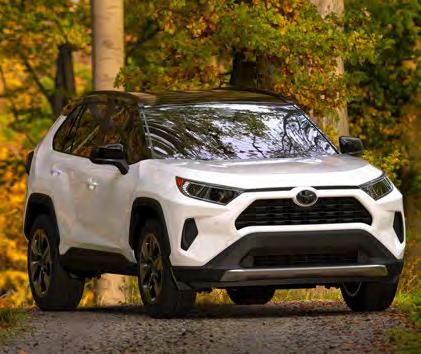
which moved 87 units. The increasing sales of hybrid models like the CR-V Hybrid show that buyers are becoming more conscious of fuel efficiency and environmental impact. As more manufacturers expand their hybrid offerings, the competition in this segment is likely to intensify, and it will be interesting to see how traditional gasoline models fare against their hybrid counterparts.
Jeep and GMC also made notable appearances in the top ten with the Jeep Grand Cherokee and GMC Sierra 1500. The Grand Cherokee’s popularity is driven by its strong off-road capabilities combined with an upscale interior, making it a versatile choice for those seeking both luxury and performance in an SUV. The Sierra 1500’s 81 units sold indicate that the pickup market remains healthy, and it’s likely a mix of both personal and commercial use that keeps it in demand.
The September sales numbers in Rhode Island and Southeastern Massachusetts provide valuable insights into regional consumer preferences. Toyota’s strong showing with a mix of SUVs, trucks, and sedans demonstrates its ability to meet the diverse needs of drivers in this market. While the SUV segment continues to dominate, the resilience of sedans and the growing popularity of hybrids suggest that a one-size-fits-all approach won’t work for automakers looking to maintain or increase market share.
As we move into the final quarter of the year, it will be interesting to see whether Toyota’s dominance continues and how hybrid and electric vehicle sales evolve in response to shifting consumer priorities. With the auto industry in a state of rapid change, staying attuned to these trends will be key for any brand looking to stay competitive in Rhode Island and Southeastern Massachusetts.
Grieco Toyota
Paul Masse Chevrolet, Inc.
Paul Masse Buick GMC South
Nucar Hyundai of North Kingstown
Balise Toyota of Warwick
Herb Chambers Honda of Seekonk
Bristol Toyota, Inc.
Nucar Toyota of North Kingstown
Grieco Honda
Nucar Toyota of North Attleboro
Grieco Acura
Speedcraft Acura
Ira Acura Westwood
Herb Connolly Acura of Framingham
Acura of Boston
Sunnyside Acura
Antonino Acura
Acura of Auburn
Pohanka Acura
Acura of Peabody
Herb Chambers Maserati of Warwick
Herb Chambers Alfa Romeo Fiat
Valenti Alfa Romeo Fiat
Maserati Motorsports of Boston
Alfa Romeo of Greenwich
Alfa Romeo of Boston
BMW of Warwick
BMW of Newport
BMW of Norwood
Herb Chambers Infiniti BMW
BMW of Sudbury
BMW of Shrewsbury
Tulley Buick GMC
South Shore BMW
Girard Toyota-BMW
BMW of Cape Cod
Audi Warwick
Audi Westwood
Volkswagen Audi Fall River
Hoffman Audi of New London
Audi Brookline
Audi Norwell
Audi Natick
Audi Shrewsbury
Audi Burlington
Audi Peabody
Buick TOTAL: 449
Paul Masse Buick GMC South
Alden Buick-GMC Truck
Tasca Buick GMC
Hurd Auto Mall
Chevrolet Buick GMC of Attleboro
Quirk Works Subaru
Brustolon Buick GMC Truck
Battles Buick GMC
Central Buick GMC, Inc.
Saybrook Buick GMC, Inc
Herb Chambers Cadillac, Inc.
Cadillac of Norwood
Mastria Buick, GMC, Cadillac, Inc.
Tracy Motors, Inc.
Long Cadillac
Herb Chambers Cadillac of Lynnfield
Colonial Cadillac
Penske Cadillac Buick
GMC South Bay
Diamond Chevrolet Buick
GMC Cadillac
Macmulkin Chevrolet Cadillac
Elmwood CDJR
Bald Hill Dodge Chrysler Jeep
Bailey's Motor Sales Inc
Hartley's
Colonial South CDJR
Mansfield Jeep Chrysler
First CDJR
Central CDJR of Raynham
Grieco CDJR
Harr CJDR
Tasca Ford Cranston
Tasca
Flood Ford of Narragansett
Grieco Kia of Raynham
Baystate Ford, Inc.
Rodman Ford Sales Inc
Franklin Ford
Jack Madden Ford Sales Inc
Top 10 Models: New Luxury Large SUVs (Total: 207)
Paul Masse Chevrolet, Inc.
Paul Masse Chevrolet South, Inc.
Balise Chevrolet of Warwick
McGee Chevrolet, Inc.
Hurd Auto Mall
Colonial South Chevrolet, Inc.
Copeland Chevrolet
Quirk Chevrolet
Tasca Chevrolet
Chevrolet Buick GMC of Attleboro
Bald Hill Dodge Chrysler Jeep
Elmwood CDJR
Central CDJR of Raynham
Stateline CDJR
Colonial South CDJR Grieco CDJR
Bailey's Motor Sales Inc
Genesis of West Warwick
Genesis of Braintree
Herb Connolly Hyundai
Autofair Hyundai-Genesis of Manchester
Mirak Hyundai Advantage Hyundai
Towne Hyundai
Herb Chambers Hyundai
Pepe Infiniti, Inc.
Genesis of Albany
Paul Masse Buick GMC South
Hurd Auto Mall
Alden Buick-GMC Truck
Station Buick GMC Mansfield
Mastria Buick, GMC, Cadillac, Inc.
Tasca Buick GMC
Chevrolet Buick GMC of Attleboro
Robertsons GMC Truck, Inc.
Quirk Works Subaru
Battles Buick GMC
Nucar Hyundai of North Kingstown
Grieco Hyundai
Empire Hyundai
First Hyundai
Pride Hyundai of Seekonk
Route 44 Hyundai
Hyundai of Newport
McGovern Hyundai
Nucar Hyundai of Norwood
Quirk Hyundai
Jake Kaplans Ltd
Land Rover Mt. Kisco Jaguar Boston
Jaguar Hartford
Ray Catena Land Rover
Jaguar Marlboro
Jaguar North Haven
Herb Chambers Honda of Seekonk
Grieco Honda
Colonial Honda of Dartmouth
Balise Honda of West Warwick
Balise Honda of North Attleboro
Silko Honda
Saccucci Honda
Ocean Honda of Brockton
Nucar Honda of Norwood
Infiniti of Hanover
Infiniti of Warwick
Infiniti of Norwood
Herb Chambers Infiniti
Infiniti of Nashua
24 Infiniti of Plymouth
Kelly Infiniti
Ramsey Infiniti, Inc.
Route 6 Automall Kia
Kia of Attleboro
Kia of Dartmouth
Bald Hill Kia
Tasca Kia
Mastria Kia
McGovern Kia of Norwood
Kia of Groton
Quirk Kia
Putnam Chrysler Dodge Jeep Inc
TOTAL: 918
Lexus of Warwick
Herb Chambers Lexus
Lexus of Watertown
Herb Chambers Lexus of Hingham
Lexus of Northborough
Hoffman Lexus
Ira Lexus of Manchester
Lexus of Palm Beach
Ray Catena Lexus of Larchmont
Metro Lexus
Maserati TOTAL: 14
Herb Chambers Maserati of Warwick
Maserati Motorsports of Boston
Alfa Romeo of Westport
Miller Motorcars
Jake Kaplans Ltd
Jaguar Norwood
Jaguar Boston
Jaguar Sudbury
Prime Hyundai South
Jaguar Peabody
Jaguar North Haven
Jaguar Albany
Land Rover Bedford
Jaguar Darien
LINCOLN TOTAL: 312
Tasca Lincoln
Flood Ford of Narragansett
Herb Chambers Lincoln
Planet Lincoln Love Field
Stivers Mazda
Sarat Ford
Maplecrest Ford of Union
David McDavid Lincoln Frisco
Dana Ford
Coccia Ford
MAZDA TOTAL: 1906
Tasca Mazda RI
Flood Mazda
Tasca Mazda MA
Alden Mazda
Mastria Mazda
Ira Mazda
Whaling City Mazda
Quirk Mazda
Patrick Mazda
Central Mazda
Patriot Subaru of North Attleboro
Anchor Subaru
Stateline Subaru
Balise Subaru
Valenti Subaru
Mastria Subaru
Quirk Works Subaru
Clay Subaru
Atlantic Subaru
Planet Subaru
Grieco Toyota
Balise Toyota of Warwick
Bristol Toyota, Inc.
Nucar Toyota of North Kingstown
Nucar Toyota of North Attleboro
Toyota of Smithfield
Toyota of Dartmouth
Route 44 Toyota
Langway Toyota of Newport
Valenti Toyota
VOLVO TOTAL: 463
Tasca Volvo Cars
Viti Volvo Cars
Steingold Volvo Cars
Herb Chambers Volvo Cars Norwood
Secor Volvo Cars
Ira Volvo Cars South Shore
Boston Volvo Cars
Volvo Cars Plymouth
Volvo Village of Danvers
Bernardi Volvo Cars Natick
Tesla Warwick
Tesla Providence
Tesla Dedham
Tesla Norwell
Tesla Sales and Delivery Mohegan Sun Blvd
Scott Volkswagen
Balise Volkswagen
Volkswagen Audi Fall River
Speedcraft Volkswagen
Volkswagen of North Attleboro, Inc.
Mastria Volkswagen of Raynham
Copeland Volkswagen of Brockton
Nucar Volkswagen of Norwood
Quirk Volkswagen
Volkswagen of Old Saybrook
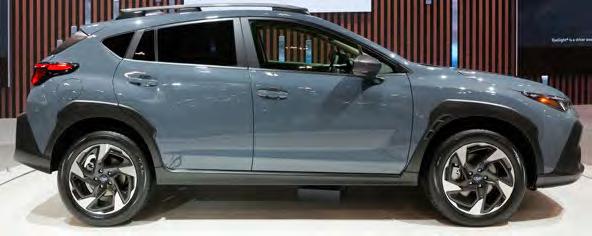
Subaru continued its stronghold in the Connecticut auto market in September, securing three of the top five bestselling vehicles. The Subaru Crosstrek, Forester, and Outback performed exceptionally well, pushing the brand to dominate the state’s SUV segment. The Crosstrek led the pack as Connecticut’s top-seller, with 348 units sold, followed by the Forester in third place with 274 units, and the Outback rounding out Subaru’s trio in fifth place at 191 units sold.
Subaru’s sales success in Connecticut is a reflection of the brand’s alignment with the preferences and driving conditions in the region. Connecticut drivers gravitate toward vehicles that can handle diverse weather conditions, offer reliability, and maintain good resale value—key attributes that have long been associated with Subaru’s lineup.
Subaru’s reputation for producing dependable, allwheel-drive vehicles continues to resonate strongly in Connecticut, a state known for its seasonal weather changes and variable road conditions. The Crosstrek, Forester, and Outback have all been mainstays in Subaru’s lineup, each offering features that Connecticut drivers prioritize: versatility, safety, and fuel efficiency.
The Subaru Crosstrek’s top-selling status is no surprise, given its balance of size, capability, and affordability. The compact SUV has consistently been a favorite among those seeking an entry-level model with a bit more ground clearance and a standard all-wheel-drive system, making it a strong choice for those navigating the state’s varied terrain.
The Forester, a perennial favorite among families and outdoor enthusiasts, combines a spacious interior with
solid fuel economy and a user-friendly infotainment system. Its popularity in Connecticut can be attributed to its comfortable ride and generous cargo space, ideal for weekend trips to the state’s scenic parks and coastal areas.
The Outback, positioned as a rugged yet refined crossover, appeals to those looking for a bit more adventure. Its higher ground clearance and advanced safety features, like Subaru’s EyeSight Driver Assist Technology, make it particularly well-suited for navigating both urban and rural environments.
While Subaru led the sales charge, other brands made a notable showing in September. Tesla’s Model Y secured second place with 297 units sold, reflecting the growing interest in electric vehicles in the state. This is a significant indicator of the region’s increasing shift toward more sustainable transportation options, and it suggests that Tesla’s presence in the market is only likely to grow.
Honda’s CR-V models, including the Hybrid version, and Toyota’s RAV4 lineup also performed well. These models continue to appeal to those seeking a balance of efficiency, reliability, and practicality. The Toyota Camry’s appearance on the list is noteworthy, demonstrating that there’s still demand for midsized sedans despite the SUV market’s dominance.
Overall, Subaru’s strong performance in Connecticut’s September sales reflects the brand’s ability to cater to the local market’s specific needs and preferences. With three models in the top five, it’s clear that Subaru remains a favorite among Connecticut drivers looking for dependable and versatile vehicles.
Connecticut September 2024
Tesla Milford
Colonial Toyota
Honda of Danbury
Tesla Sales and Delivery Mohegan Sun Blvd
Dan Perkins Subaru
Lynch Toyota
Partyka Chevrolet Inc.
Loehmann-Blasius Chevrolet, Inc.
Honda of Westport
Hartford Toyota
Connecticut January through September 2024
Acura of Milford
Acura of Stamford
Acura of Berlin
Acura By Executive
Acura of Avon
Devan Acura of Norwalk
Schaller Acura
Antonino Acura
Acura of Westchester
Acura of Bedford Hills
Valenti Alfa Romeo Fiat
Alfa Romeo of Westport
Alfa Romeo of Greenwich
Danbury Alfa Romeo Fiat
Ramsey Alfa Romeo Fiat
Alfa Romeo Fiat of Westbury
Herb Chambers Maserati of Warwick
Maserati Alfa Romeo Englewood Cliffs
Audi Willow Grove
Safford Alfa Romeo of Tysons Corner
BMW TOTAL: 3116
Continental BMW of Darien
BMW of North Haven
New Country BMW
BMW of Ridgefield
BMW of Bridgeport
BMW of Greenwich
BMW of Waterbury
Girard Toyota-BMW
BMW of Westchester
BMW of West Springfield
Audi of Fairfield
Hoffman Audi
Audi Greenwich
Audi Danbury
Audi of Wallingford
Valenti Audi
Hoffman Audi of New London
Audi New Rochelle
Audi West Springfield
Audi Manhattan
D'Addario Buick GMC
Cadillac Nissan
Saybrook Buick GMC, Inc.
Stephen Cadillac GMC, Inc.
Ingersoll Auto of Danbury
Buick GMC of Watertown
Brustolon Buick GMC Truck
Minchin Buick - GMC, Inc.
White Plains Buick GMC
Bob Pion Buick-GMC, Inc.
Wallingford Buick GMC Buick TOTAL: 448
Loehmann-Blasius
Chevrolet, Inc.
Cadillac of Greenwich
D'Addario Buick GMC
Cadillac Nissan
Valenti Cadillac, LLC
Ingersoll Auto of Danbury
Stephen Cadillac GMC, Inc.
Scranton Motors, Inc.
Colonial Chevrolet-Cadillac
Hyundai
Northwest Hills Chevrolet Buick GMC Cadillac
Pepe Cadillac
Mitchell Subaru
Papa's Dodge Inc
Bob Valenti Chevrolet, Inc.
Gengras Chrysler Dodge Jeep LLC
Branhaven Chrysler Jeep Dodge
Robert's Chrysler Dodge Ram Fiat
Danbury CJDR Fiat
Putnam Chrysler Dodge Jeep Inc
Secor CDJR
Crowley CDJR
Columbia Kia
Shaker's Family Ford
Loehmann-Blasius Chevrolet, Inc.
Richard Chevrolet, Inc.
Chevrolet of Milford, Inc.
Dave McDermott Chevrolet, Inc.
Partyka Chevrolet Inc.
Ingersoll Auto of Danbury
Gengras Chevrolet Inc.
Valenti Auto Sales Inc
Maritime Chevrolet
Carter Chevrolet Top
Crowley CDJR
Robert's Chrysler Dodge Ram Fiat
Artioli Chrysler Dodge
Papa's Dodge Inc
Gengras Chrysler Dodge Jeep LLC
Branhaven Chrysler Jeep Dodge
Shaker's CDJR
Executive Dodge and Jeep of Wallingford
Danbury CJDR Fiat
Secor CDJR
Genesis of Milford
Meriden Hyundai
Balise Hyundai of Fairfield
Garavel Subaru
Pepe Infiniti, Inc.
Stamford Hyundai LLC
Country Hyundai
Honda of Danbury
Genesis of West Warwick
Colonial Chevrolet Cadillac-Hyundai
D'Addario Buick GMC Cadillac Nissan
Ingersoll Auto of Danbury
Minchin Buick - GMC, Inc.
Buick GMC of Watertown
Scranton Motors, Inc.
Tremonte Auto Group Inc
Gates Buick GMC
Wallingford Buick GMC
Gallagher Buick GMC Inc.
Saybrook Buick GMC, Inc.
Honda of Danbury
Key Hyundai of Milford
Meriden Hyundai
Stamford Hyundai LLC
Brandfon Hyundai
Key Hyundai of Manchester Lia Hyundai
Shakers Family Hyundai
Balise Hyundai of Fairfield
Colonial Chevrolet
Cadillac-Hyundai
Jaguar Hartford
Jaguar North Haven
Jaguar White Plains
Jake Kaplans Ltd
Land Rover Mt. Kisco
Jaguar Brooklyn
Jaguar Palm Beach
Jaguar Clear Lake
Imperial Motors Jaguar of Lake Bluff
Honda of Westport
Manchester Honda
Schaller Honda
Liberty Honda
Honda of Stamford
Curtiss Ryan Honda
Executive Honda
Honda of Danbury
Honda of Watertown
Hoffman Honda
George Harte Infiniti
Devan Infiniti/Fairfield
Harte Infiniti, Inc.
Greenwich Infiniti
Bruce Bennett Nissan of Danbury
Volvo Cars White Plains
Infiniti City of Queens
Kings Infiniti, Inc.
Ramsey Infiniti, Inc.
Infiniti of Warwick
Scap CDJR
Garavel CJDR
Branhaven Chrysler Jeep Dodge
Milford CJDR
Crowley CDJR
Fitzpatricks Inc
Gengras Chrysler Dodge Jeep LLC
CDJR City
Papa's Dodge Inc
Shaker's CDJR
Blasius Kia
Kia of East Hartford
Crowley Kia
Napoli Kia
Premier Kia
Executive Kia
Danbury Kia
Kia Motors of Old Saybrook
Columbia Kia
Kia of Stamford
LEXUS TOTAL: 2376
Hoffman Lexus
New Country Lexus of Westport
Dave McDermott Chevrolet, Inc.
Lexus of Greenwich
DARCARS Lexus of Mt Kisco
Balise Lexus
Lexus of Warwick
Ray Catena Lexus of Larchmont
Ray Catena Lexus of White Plains
Herb Chambers Lexus
Maserati TOTAL: 65
Miller Motorcars
Alfa Romeo of Westport
Valenti Alfa Romeo Fiat
Danbury Alfa Romeo Fiat
Maserati Motorsports of Boston
Herb Chambers Alfa Romeo Fiat
Alfa Romeo-Fiat of Naperville
Maserati of Newport Beach
Maserati of Troy
Northside Alfa Romeo Fiat
992
Jaguar Darien
Jaguar Fairfield
Jaguar North Haven
Land Rover Hartford
Land Rover Mt. Kisco
Jaguar White Plains
Jaguar New Rochelle
Jaguar Brooklyn
Jaguar Manhattan
Jake Kaplans Ltd
TOTAL: 311
Crest Jaguar of Woodbridge
Hoffman Ford Inc
Shaker's Family Ford
Jaguar White Plains
Stevens Ford Inc
Sarat Ford
Tasca Mazda Volvo RI
Maplecrest Ford of Union
Dana Ford
Empire Ford of Huntington
MAZDA TOTAL: 4618
Partyka Chevrolet Inc.
Mazda of Milford Riley Mazda Liberty Mazda
Mazda of Manchester
Mercedes-Benz of Fairfield
New Country Motor Cars
Mercedes-Benz of North Haven
Mercedes-Benz of Greenwich
Mercedes-Benz of Danbury
Carriage House of New London
Mercedes-Benz of White Plains
Mercedes-Benz of Springfield
Mercedes-Benz Manhattan
Mercedes-Benz of Goldens Bridge
Top 10 Models: New Luxury Large SUVs (Total: 207)
Midstate Mitsubishi CT
Team Mitsubishi Hartford
Bob's Buick GMC of Milford
Victory Mitsubishi
Midstate Mitsubishi MA
Prestige Mitsubishi
Northstar Kia Mitsubishi
Bell Mitsubishi
Fayetteville Mitsubishi
Big City Mitsubishi
Porsche TOTAL: 609
Porsche Fairfield
Porsche Greenwich
Audi of Wallingford
Hoffman Porsche
Porsche Danbury
Porsche Warwick
Porsche of Southampton
Manhattan Motorcars
Porsche Larchmont
Porsche Huntington
MINI TOTAL: 275
MINI of Fairfield County
New Country MINI
BMW of Westchester
BMW of Warwick
BMW of Manhattan
MINI of Freeport
Habberstad MINI
Prestige MINI
MINI of Bedford
Herb Chambers Infiniti BMW
Middletown Nissan
Manchester City Nissan
D'Addario Buick GMC
Cadillac Nissan Crabtree Nissan
Bruce Bennett Nissan
Crowley Nissan
Barberino Nissan
Gates Buick GMC
George Harte Nissan, Inc.
Paul Miller Nissan, LLC
RAM TOTAL: 1099
Branhaven Chrysler Jeep Dodge
Papa's Dodge Inc
Capitol Garage Inc
Crowley CDJR
Gengras Chrysler Dodge Jeep LLC
Executive Dodge and Jeep of Wallingford
Artioli Chrysler Dodge
Robert's Chrysler Dodge
Ram Fiat
Danbury CJDR Fiat
Bob Valenti Chevrolet, Inc.
SUBARU TOTAL: 9567
Dan Perkins Subaru
Bertera Subaru of Hartford
Premier Subaru
Colonial Subaru
Mitchell Subaru
Premier Subaru Middlebury
Suburban Subaru
Garavel Subaru
Schaller Subaru
Subaru Stamford
Colonial Toyota
Lynch Toyota
Hartford Toyota A-1 Toyota
Curry Toyota
Toyota of Stamford
Middletown Toyota
Wow Toyota of Wallingford
Greentree Toyota
Hoffman Toyota
VOLVO TOTAL: 1730
Volvo Cars Westport
Riley Volvo Cars Stamford
Kia of East Hartford
Volvo Cars Danbury
Gengras Volvo Cars North Haven
Mitchell Volvo Cars
Secor Volvo Cars
Valenti Volvo Cars Watertown
Volvo Cars White Plains
Volvo Cars Ramsey
Tesla Milford
Tesla Sales and Delivery
Mohegan Sun Blvd
Tesla WestchesterMt. Kisco
Tesla White PlainsTarrytown
Tesla Providence
Tesla Warwick
Curran Volkswagen, Inc.
Gene Langan Volkswagen, Inc.
Danbury Volkswagen
Executive Volkswagen of North Haven Volkswagen of Old Saybrook
Gengras Volkswagen of Plainville
Valenti Audi
Prestige Volkswagen of Stamford
Vernon Volkswagen
Harte Volkswagen of Meriden

The New England auto dealership market has witnessed several key buy-sell transactions in 2024, reflecting ongoing industry shifts. Notable acquisitions include McGovern Automotive Group’s purchase of Toyota of Portsmouth in New Hampshire, Colonial Auto Group’s acquisition of M.J. Sullivan Automotive in Connecticut, and Grieco Automotive Group’s expansion in Massachusetts with the acquisition of Dan O’Brien ChryslerDodge-Jeep-Ram in Methuen. These transactions are part of a broader trend as dealerships adjust to changing market conditions and ownership transitions across the region.
• McFarland Kia (formerly Enxing Kia in North Hampton, N.H.)
Buyer: Chris Lane
Seller: Dan Enxing
Transaction Date: July 17, 2024
• Portsmouth Volkswagen (formerly Seacoast Volkswagen in Greenland, N.H.)
Buyer: International Cars Ltd. (ICL Family of Dealerships)
Seller: Doug and Nora Miles
Transaction Date: May 1, 2024
• Grieco Chrysler-Jeep-Dodge-Ram (formerly Dan O’Brien Chrysler-Dodge-Jeep-Ram in Methuen, Mass.)
Buyer: Grieco Automotive Group
Seller: Dan O’Brien of Dan O’Brien Auto Group
Transaction Date: July 11, 2024
• Matthews Nissan of Wellesley (formerly Bernardi Nissan in Wellesley, Mass.)
Buyer: Matthews Auto Group
Seller: Jim Carney of Bernardi Auto Group
Transaction Date: May 2, 2024
• Lexus of Manchester (formerly Ira Lexus of Manchester in Bedford, N.H.)
Buyer: Sheree Kaplan-Allen, owner of Kaplan Auto Group
Seller: Group 1 Automotive
Transaction Date: May 13, 2024
• McGovern Toyota of Portsmouth (formerly Toyota of Portsmouth in Portsmouth, N.H.)
Buyer: McGovern Automotive Group
Seller: Jim Boyle
Transaction Date: April 10, 2024
• Colonial Chevrolet-Cadillac-Hyundai (formerly M.J. Sullivan Automotive Corner in New London, Conn.)
Buyer: David and Darren Beylouni of Colonial Auto Group
Seller: Bill Sullivan Jr.
Transaction Date: March 6, 2024
• Nucar Ford of Lebanon (formerly Lebanon Ford in Lebanon, N.H.)
Buyer: Chris and Dan Dagesse of DCD Automotive Holdings
Seller: John Loschiavo of Saint J Auto
Transaction Date: March 5, 2024
The Mayor of Cranston, Rhode Island, Kenneth Hopkins, is facing a lawsuit that paints him as a “thieving bully” after an alleged dispute involving a 1975 MGB roadster. The legal action, filed by Providence resident Davide Broccoli, accuses the mayor of driving off in the classic British sports car without paying for it or even agreeing to a sale, raising questions about ethics, propriety, and the pressures of political office.
At the heart of the dispute is the vintage roadster, a car that initially caught Hopkins’ eye because its “MG” badge matched the initials of his late wife. Both men agree that Hopkins visited Broccoli’s property in 2021, where the car had been parked among dozens of other classic vehicles stored behind a chain-link fence. What happened next is a matter of bitter dispute.
According to Broccoli, there was no discussion of selling the MGB when Hopkins arrived at the property. Broccoli claims Hopkins was only interested in seeing the car, as he was captivated by its iconic MG emblem. The car hadn’t been driven in months, and it took some effort—jumping the battery using Hopkins’ city-owned SUV—just to get the engine running.
Broccoli alleges that after test driving the car forward and in reverse, Hopkins declared, “I’m taking it,” and without hesitation, drove the vehicle off his lot. According to Broccoli, when he asked how Hopkins planned to drive it away without proper registration or ensuring its roadworthiness, the mayor allegedly responded, “I’m the mayor. I can do what I want.”
Since that day, Broccoli says Hopkins has persistently harassed him to turn over the car’s title. Broccoli also accuses the mayor of interfering with his business dealings, claiming Hopkins dissuaded a potential tenant from leasing one of his properties and even orchestrated the removal of dozens of classic cars from his lot, further aggravating their already tense relationship.


At the heart of the dispute is the vintage roadster, a car that initially caught Hopkins’ eye because its “MG” badge matched the initials of his late wife.

On the other hand, Hopkins tells a different story, calling the lawsuit a politically motivated stunt aimed at tarnishing his image ahead of the Republican primary. He claims Broccoli willingly handed him the keys and agreed to sell him the MGB for $1,200. According to Hopkins, there was a verbal agreement to finalize the sale, but Broccoli never followed through with delivering the necessary paperwork or title transfer.
“My attorney said that once you got the keys and drove it away, you were in a verbal agreement to purchase the car,” Hopkins told The Boston Globe. “It’s not like I went over and stole the car.”
However, three years after the incident, the title remains unresolved. Hopkins admits that without a bill of sale or money exchanging hands, the situation looks murky at best. Despite this, he contends that the lawsuit’s timing—filed just days before a GOP primary—proves it is politically motivated.
Hopkins, who had the car repainted and fitted with new leather seats, maintains that the lawsuit is simply a tactic to create drama and damage his candidacy.
The conflict between Broccoli and Hopkins seems to extend beyond the car. Broccoli claims that the mayor, through his influence, has subjected him to continuous harassment, including the forced removal of other classic vehicles from his property and meddling in his real estate dealings. Broccoli also asserts that the city caused damage to one of his buildings,
resulting in $75,000 in repairs after officials removed a vintage sign.
Hopkins, however, dismisses these accusations, asserting that any interference with Broccoli’s properties was the result of standard city procedures. “Those cars must have either been illegally parked or a blight to the city,” he stated in response to the forced removal of vehicles.
As the case unfolds, the 1975 MGB roadster at the center of this controversy now sits in Hopkins’ garage, unused and uninsured, while the two parties battle it out in court. Broccoli’s lawsuit demands the return of the vehicle and an additional $15,000 in compensation for the changes Hopkins made to the car, including the new paint job and leather seats.
The fate of the car—and the lawsuit—now lies in the hands of the court. But as both men publicly air their grievances, it’s clear that this is more than just a dispute over a classic car. The incident has morphed into a politically charged battle, raising questions about the conduct of a sitting mayor and the ethical boundaries of local government.
While Broccoli claims his lawsuit is an attempt to resolve an issue that has dragged on for years, Hopkins contends that the legal action is nothing more than an effort to smear his name in the lead-up to the Republican primary. Regardless of the outcome, the case shines a spotlight on the intersection of personal disputes and political ambition, adding a new layer of intrigue to Cranston’s political landscape.
In the meantime, the classic MGB—once a symbol of British automotive heritage—remains trapped in legal limbo, a pawn in a bitter personal and political showdown.
A number of major automakers have issued vehicle recalls for October, addressing safety concerns in several models. The recalls cover a variety of issues ranging from electrical malfunctions to faulty components that could pose risks to drivers and passengers. Below are key details of the most significant recalls announced:

• 2023 Kia Sportage: Kia is recalling 19,701 vehicles due to the potential loosening of the alternator battery terminal nut. This issue can lead to engine stalls or electrical surges, increasing the risk of a crash or fire. Kia dealers will inspect and tighten the terminal as needed at no charge to owners, with notifications expected to begin on September 23, 2022.
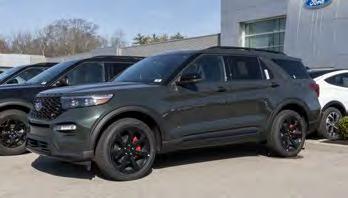
• Ford Expedition and Lincoln Navigator (2015-2017): A total of 198,482 vehicles are affected by this recall due to the risk of failure in the front blower motor, which could lead to vehicle fires. Ford will replace the front blower motor assembly, and owner notification letters will be sent starting September 12, 2022.

• Ford Super Duty and Lincoln Continental (2017-2020): Ford is recalling 277,040 vehicles due to a degradation of the rearview camera’s anti-reflective lens coating, which can impair visibility and increase the risk of an accident. The recall includes F-Super Duty trucks and Lincoln Continental models, with repairs consisting of a rearview camera replacement.

• Chevrolet Spark and Spark EV (2013-2015): General Motors is recalling 120,688 Spark models due to potential failure of the secondary hood latch, which can lead to the hood opening unexpectedly while driving. Dealers will replace both the hood latch and striker assemblies.
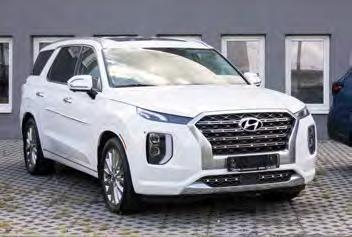
• Hyundai Palisade (2020-2022): Hyundai is recalling 245,030 Palisade vehicles equipped with tow hitch harnesses that could accumulate debris and moisture, possibly causing an electrical short and increasing the risk of fire. Hyundai advises owners to park outside and away from structures until repairs can be completed.
For more details, you can contact the manufacturers’ customer service lines or visit the National Highway Traffic Safety Administration (NHTSA) website.

Infiniti is planning a significant overhaul of its utility vehicle lineup in the coming years as the brand struggles to regain relevance in the luxury market. The brand’s share of the market has declined dramatically, dropping from 7.4% in 2017 to just 2.4% in 2023. In response, Infiniti sold only 64,699 vehicles in the U.S. last year, marking its fifth consecutive year of decline.

Acura has revealed that it is working on an electric sports car reminiscent of the NSX, slated for a 2028 launch. This new model will be built on Honda’s 0 Series electric platform, which was showcased earlier in 2024. The platform is thinner and lighter, allowing for better design flexibility, including a low-height vehicle with a more spacious cabin.
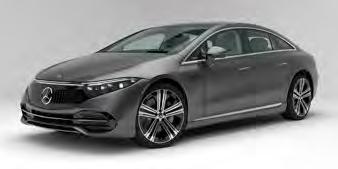
Mercedes-Benz is redesigning its S-Class model to include both electric and combustion engine versions. Meanwhile, the EQS sedan will be discontinued after just one generation due to poor sales performance. Mercedes plans to shift its focus to a unified S-Class model by 2030, blending luxury, performance, and cutting-edge electric vehicle technology.

Scout Motors is set to unveil its first vehicle on October 24, 2024. The vehicle, which is expected to be an electric SUV, will bring back the legacy of the International Harvester Scout, one of the first SUVs ever produced. This announcement comes after years of anticipation and teasers from the Volkswagen-backed company.

5. Hyundai’s N Vision 74 Coupe May Be Heading to Production
Hyundai has hinted that its N Vision 74 Coupe, which was initially
revealed as a concept vehicle, may be heading toward production. This coupe is part of Hyundai’s plan to release 21 fully electric models by 2030. Inspired by the 1974 Pony Coupe concept, the N Vision 74 blends retro design with cutting-edge EV technology.

1. Tesla to Open First Store in Western Massachusetts
Tesla has received approval to open its first store in Western Massachusetts, in East Springfield. The 35,700-square-foot facility will include a service center and a parking lot for up to 360 vehicles. This new location will provide more convenience to Tesla customers in the area, as the closest existing centers are in Boston and Rhode Island.

2. Rhode Island Senate Passes Bill to Protect OEM Parts in Repairs
The Rhode Island State Senate has passed a bill extending protections for original equipment manufacturer (OEM) parts in car repairs. If signed into law, the bill would prevent insurance companies from mandating the use of non-OEM parts for vehicles aged 48 to 72 months, as long as the vehicle owner consents in writing. Supporters argue it ensures vehicle safety, while critics fear it may drive up repair costs.

3. Massachusetts Right to Repair Law Remains Stalled in Court
Massachusetts’ Right to Repair law, passed by voters in 2020, remains stalled in the courts as automakers continue to challenge the legislation. The law would require car manufacturers to share diagnostic data with independent repair shops, but a federal judge has yet to issue a ruling, leaving consumers and repair shops in limbo.

As the market for luxury and exotic cars remains strong, three vehicles have emerged as the most expensive listings in Rhode Island, Massachusetts, and Connecticut. These vehicles are noteworthy for their high-performance capabilities, advanced technology, and, of course, their significant price tags.



In Massachusetts, the most expensive vehicle currently on the market is a 2021 Ferrari 812 GTS, listed at $659,900. This grand tourer, with 3,820 miles on the odometer, features a 6.5-liter V12 engine that produces 788 horsepower. The car can accelerate from 0 to 60 mph in 2.7 seconds and has a top speed of 211 mph.
The 812 GTS is equipped with a 7-speed automatic transmission and rear-wheel drive. It also includes features such as adaptive suspension, ceramic disc brakes, a power convertible roof, and leather upholstery. The vehicle is available at Boch Maserati Ferrari of New England, and its Bianco Cervino exterior combined with Nero leather seats contributes to its premium status.
In Connecticut, the 2015 McLaren P1 is currently the most expensive vehicle for sale, with a listing price of $1,995,000. This hypercar has only 859 miles on it and features a plug-in hybrid powertrain that combines a twin-turbocharged 3.8-liter V8 engine with an electric motor, producing a total of 903 horsepower.
The McLaren P1, finished in MSO Kilo Grey with Carbon Black leather seats, is known for its high-performance capabilities, including a 0 to 60 mph time of 2.8 seconds. The vehicle’s hybrid system allows it to run on electric power alone for up to 19 miles. This model is available at Miller Motorcars.
The most expensive vehicle listed in Rhode Island is the 2024 Porsche 911 Dakar, priced at $349,900. This vehicle has 800 miles on the odometer and is powered by a 3.0-liter turbocharged flat-six engine. The 911 Dakar is designed to perform both on and off the road, with an elevated suspension and a specially tuned allwheel-drive system.
This Porsche model includes features such as ceramic brakes, a customizable suspension system, and an advanced infotainment system. The vehicle is available through Automotive Collection Sales & Management.

After facing nearly two years of record low inventory due to supply chain disruptions and production delays, the U.S. automotive industry is finally seeing an increase in vehicle supply as of September 2024. This shift marks a significant milestone, as inventory levels now exceed historical norms following a prolonged period of car shortages. New car buyers can expect more options and potentially better deals as the market rebalances.

Market Day Supply (MDS)—which measures the number of days it would take to sell all current inventory based on the previous month’s sales rate—has increased across most brands, indicating rising availability. As of this month, the industry average MDS stands at 93 days, with 3.17 million new vehicles available for sale.
Notable trends in inventory include:
• Ford leads with the highest new inventory count of 487,944 vehicles and a supply of 137 days, showing improvement from previous shortages.
• Honda and Kia stand out with lower-than-average MDS—64 and 77 days respectively—while also maintaining strong inventory levels, indicating that these brands are moving their stock faster than the industry norm.
• Toyota has the lowest MDS at just 38 days, reflecting continued high demand for its vehicles, with 234,983 cars in inventory.
• Luxury brands like Lexus (47 days) and Mercedes-Benz (156 days) show varying trends, with Lexus moving faster through inventory while Mercedes-Benz holds a higher supply.
As the supply of cars improves, buyers are encouraged to keep an eye on brand trends, as MDS and inventory levels vary significantly across manufacturers. Brands like Ram and Jeep show some of the highest MDS, with Ram at 214 days and Jeep at 169 days, signaling an oversupply that could lead to increased incentives or discounts in the near future.
The gradual recovery in inventory levels is good news for consumers, offering a more favorable market for those seeking new vehicles.



The data reflects varying levels of supply across brands, with manufacturers like Toyota, Lexus, and Honda maintaining quicker sales cycles, while others like Ram, Jeep, and Mercedes-Benz accumulate more inventory. The continued increase in vehicle availability bodes well for the auto industry as it strives to recover from supply chain disruptions.
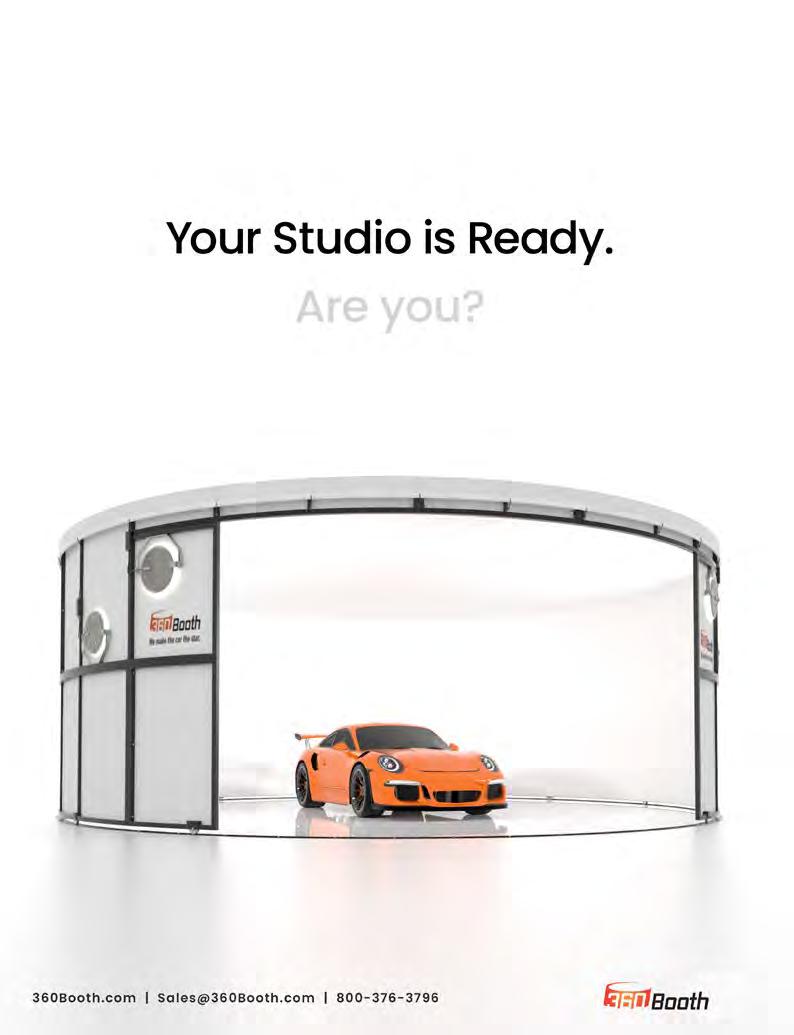



The 2025.5 Volvo XC90 represents a significant refresh of Volvo’s flagship SUV, blending modern design elements from its electric EX90 sibling while maintaining a strong lineup of hybrid and mild-hybrid powertrains. Though not a complete overhaul, the changes enhance the XC90’s appeal, particularly for drivers not ready to transition fully to electric vehicles. Offering luxurious comfort, advanced safety features, and a blend of gasoline and electric power, the XC90 is a top contender in the premium three-row SUV market.
Performance: The XC90 is available in three primary models: the B5, B6, and Recharge plug-in hybrid.
• B5: This version is powered by a 2.0-liter turbocharged inline-4 engine with a 48-volt mild-hybrid system. This setup produces around 247 horsepower. It’s ideal for drivers seeking fuel efficiency combined with decent power for daily commutes.
• B6: Offering a performance boost, the B6 adds a supercharger to the 2.0-liter engine, bringing the output to approximately 295 horsepower. The extra power provides a more engaging driving experience, making it suitable for those who want more responsiveness in city or highway driving.
• Recharge (T8): The plug-in hybrid (PHEV) variant delivers a combined 455 horsepower, courtesy of its turbocharged engine and electric motor combination. It also offers a pure electric range of around 33 miles (WLTP estimates claim over 70 km) on a full charge. This model is perfect for those who prefer electric driving for shorter trips while still needing the flexibility of a gasoline engine for longer journeys. The Recharge also delivers all-wheel drive, making it a strong choice for varying road conditions.

In terms of ride comfort, the XC90 has improved adaptive dampers as standard, which adjust to road conditions. The air suspension option enhances this further, offering height adjustments for easier entry or better off-road capability, lowering the vehicle by 20mm or raising it by 40mm depending on the situation.
• B5 & B6: The mild-hybrid models aim for fuel efficiency, with expected fuel consumption in the range of 20-25 mpg combined (city/highway). These figures are approximate, as official numbers have yet to be released for the 2025 model.
• Recharge (T8): The plug-in hybrid offers impressive efficiency, especially for city drivers who can take full advantage of its electric-only range. Using a regular outlet, charging the battery takes several hours, while a fast charger reduces that time considerably. The 2025.5 Volvo XC90 Recharge (T8) plug-in hybrid offers an estimated 33 miles of pure electric driving range on a full charge. This allows for significant fuel savings on shorter trips, especially for those who can charge frequently.
In terms of fuel efficiency when using both the gasoline engine and electric motor (in hybrid mode), the Recharge is expected to achieve approximately 58 MPGe (miles per gallon equivalent) based on previous models, though official 2025 figures have

not yet been released. This rating reflects combined efficiency when factoring in both electric and gasoline usage.
When running solely on the gasoline engine after the electric range is depleted, the XC90 Recharge typically returns around 26 MPG combined, depending on driving conditions and usage patterns.
Exterior Design: The 2025.5 XC90 incorporates subtle yet impactful design changes. The front and rear facias are updated, with the signature Thor’s Hammer LED headlights now integrating into the grille more seamlessly. New wheel designs add a fresh look to the side profile, and the grille itself features a crosshatch pattern reminiscent of the EX90. Darkened taillights further modernize the rear, giving it a more aggressive stance.
The overall design aligns the XC90 closer to Volvo’s electric models, signaling a shift towards a more electrified future while retaining the classic XC90 shape.
Interior & Technology: Inside, the XC90 sees more noticeable upgrades:
• Central Display: A larger 11.2-inch touchscreen now anchors the dashboard, running Google’s Android-powered infotainment system. The improved display has a 21% higher pixel density, making navigation, media controls, and app usage smoother and clearer.
• Cabin Materials: Volvo maintains its commitment to sustainability by using premium recycled materials in the dashboard, which now has a more horizontal layout. New vertical air vents are designed to match the screen’s shape.
• Seating & Comfort: Known for its comfort, the XC90 continues to offer plush seating for seven passengers, with additional improvements in noise insulation. Laminated windows and extra soundproofing in the A- and B-pillars contribute to a quieter cabin.
• Features: A standout feature is the Bowers & Wilkins High Fidelity audio system, providing concert-hall-quality sound. Volvo also added extra storage in the center console, including another cupholder and a wireless phone charger repositioned for easier access.
Safety: As with all Volvos, the 2025.5 XC90 is among the safest vehicles on the road. It boasts a reinforced safety cage and an advanced suite of active safety technologies. These include:
• Lane Keep Assist: Detects when the vehicle drifts into the oncoming lane and can steer it back safely.
• Run-off Road Mitigation: Prevents the vehicle from unintentionally veering off the road.
• Collision Avoidance: Uses radar and cameras to detect potential collisions with vehicles, pedestrians, cyclists, or large animals like moose. The system can automatically brake or steer to avoid accidents.
Pricing: The 2025.5 Volvo XC90 starts at $59,745, including destination charges, for the base B5 model. The pricing increases with additional features and higher trim levels, especially for the B6 and Recharge models, which add more power and luxury options.


Final Thoughts: The 2025.5 Volvo XC90 continues to be a leader in the luxury SUV segment, offering a balanced combination of hybrid efficiency, advanced technology, and top-notch safety features. Its refreshed design, improved infotainment, and smoother ride dynamics make it an appealing choice for families and environmentally conscious drivers. While the EX90 electric SUV represents Volvo’s future, the XC90’s combination of gasoline and electric power ensures it remains a vital part of the lineup during the transition to full electrification.
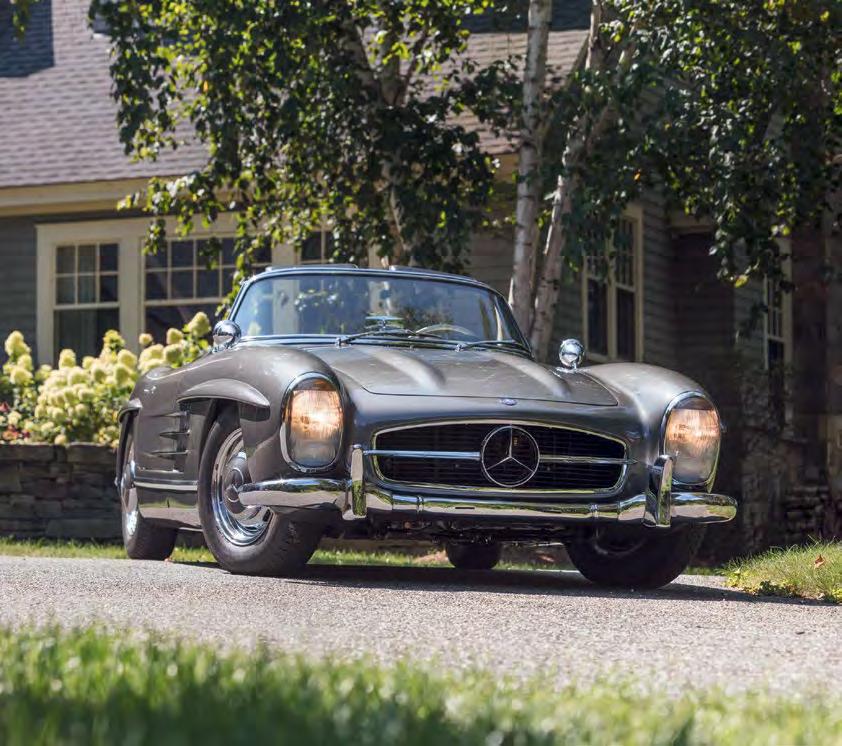
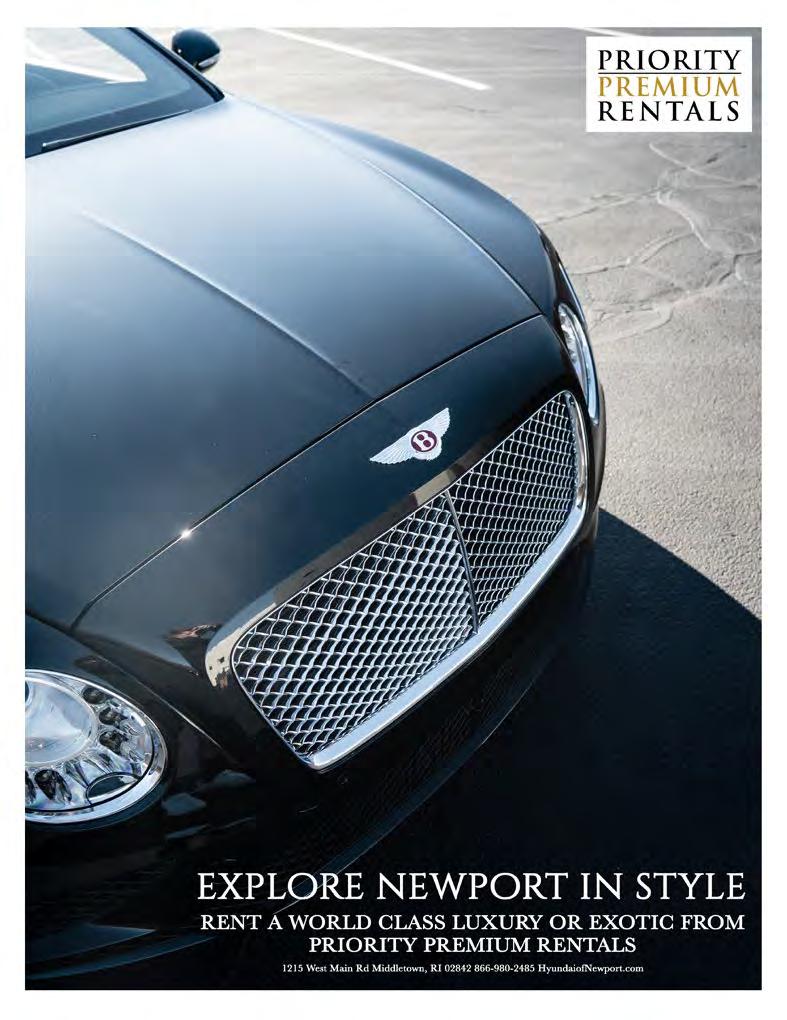

Begin your adventure in Waterbury, a picturesque town that serves as the gateway to the Green Mountain Byway. Known for its charming streets lined with quaint shops and cafes, Waterbury is also home to one of Vermont’s most famous landmarks: the Ben & Jerry’s Factory. No trip to Waterbury is complete without a stop here for a tour (and a taste!) of some of the nation’s most beloved ice cream. For a more traditional Vermont flavor, head to Cold Hollow Cider Mill to sample their fresh-pressed apple cider and irresistible cider donuts, a fall favorite.
Waterbury offers several cozy inns and bed-and-breakfast options. The Old Stagecoach Inn, dating back to the early 19th century, combines history with modern comforts. For a more luxurious stay, try the Hen of the Wood, which also has one of the best farm-to-table restaurants in the region.
Leaving Waterbury, you’ll officially be on the Green Mountain Byway, which winds through the heart of Vermont’s autumn landscape. Your drive will take you past scenic farm fields, dense woodlands, and rolling hills, all blanketed in stunning reds, oranges, and yellows during peak foliage season.
Along the route, be sure to stop at the Little River State Park. This serene park offers hiking trails that provide panoramic views of the surrounding mountains. The Waterbury Reservoir, located within the park, is perfect for a peaceful paddle or a moment of reflection on its glassy waters, framed by a sea of changing leaves.
For photography enthusiasts, the Worcester Mountain Range offers breathtaking vistas that are particularly stunning in the morning when the mist rises over the peaks, giving the entire landscape a dreamlike quality.
Your destination is Stowe, one of Vermont’s most iconic towns. Famous for its ski slopes in the winter, Stowe transforms into a foliage wonderland during the fall. The town itself has a

lively yet relaxed atmosphere, with art galleries, boutiques, and farm-to-table restaurants lining the main street. You’ll also find plenty of opportunities for outdoor activities, from hiking to mountain biking.
For the ultimate foliage experience, take the Auto Toll Road to the top of Mount Mansfield, Vermont’s highest peak. The drive offers jaw-dropping views of the valley below and the surrounding mountains, with foliage stretching as far as the eye can see. At the summit, there are several short hiking trails that offer even more incredible panoramic vistas.
For hikers, Stowe offers some of the best trails in New England. One favorite is the Stowe Pinnacle Trail, a moderately challenging hike that rewards you with a 360-degree view of the surrounding mountains. For a more leisurely walk, the Stowe Recreation Path is a peaceful 5.5-mile trail that meanders through woods, meadows, and alongside a bubbling brook.
Stowe offers an array of accommodations that cater to both

luxury travelers and those looking for a rustic Vermont experience. For a high-end stay, Topnotch Resort is a premier choice, offering spa services and fine dining. For a cozy, homey vibe, Green Mountain Inn in the heart of downtown Stowe has been hosting guests for over 180 years.
No trip through Vermont would be complete without visiting some of its iconic covered bridges. Just outside Stowe, you’ll find the Gold Brook Covered Bridge, also known as Emily’s Bridge. This bridge, built in 1844, is steeped in local legend and offers a hauntingly beautiful spot for photos, especially with fall foliage in the background.
As you drive through the region, take time to stop at local farms for fresh produce, Vermont cheeses, and homemade maple syrup. Many farms offer tours, and during the fall, you might even catch a festival or two celebrating the harvest season.
If you’re looking to extend your road trip, consider looping back through Smugglers’ Notch, one of Vermont’s most dramatic mountain passes. The road here is narrow and winding, but the reward is awe-inspiring views of towering cliffs and dense forests. It’s an exciting drive, especially during foliage season, as you navigate through tunnels of vibrant fall colors.
Vermont’s Green Mountain Byway is one of the most breathtaking fall road trips in New England. Whether you’re indulging in local delicacies, hiking mountain trails, or simply taking in the kaleidoscope of colors along the way, this trip offers something for every traveler. Don’t forget your camera— these views are ones you’ll want to capture and remember.
For your next fall adventure, pack up the car and head to Waterbury and Stowe. It’s a journey you won’t forget, as Vermont’s autumn scenery and welcoming small towns will leave you captivated by the season’s natural beauty.



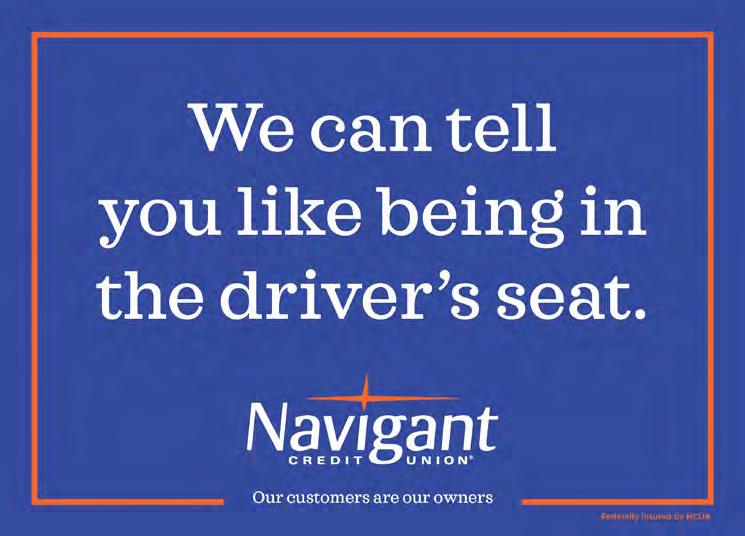
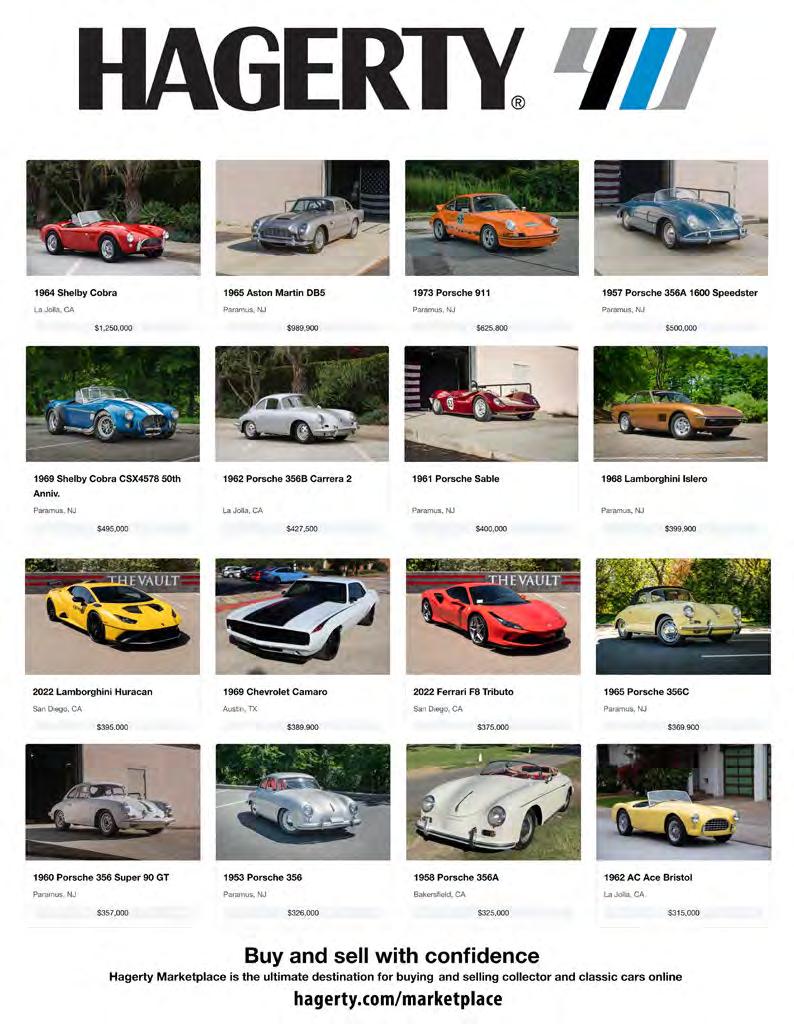

I recently was enjoying a peaceful day at the beach where the waves gently lapped the shore, families played in the sand, and the breeze carried the soft sound of seagulls— everything one could ask for in a serene, coastal experience. Except that the tranquility was suddenly shattered by the incessant buzz of a plane dragging a massive banner through the sky.
The noise was deafening as the plane tried to get low enough to the beach so everyone saw the banner. It read “Paul Masse,” a car dealership that beachgoers can now thank for this disruption.
In fact, this wasn’t the only time I recently encountered this. It happened again when we went to view the Great Elephant Migration display at Rough Point. And a third time in less than a month, while biking along the Ocean Drive in Newport. The planes were there, circling overhead, and spoiling the atmosphere. And every time, dragging a Paul Masse banner. The sentiment among the people around me was the same: frustration. Several mentioned how this noisy intrusion into their peace and quiet made them want do anything to avoid the very brands being advertised. Banner planes, which seem like an outdated and intrusive form of advertising, are clearly having the opposite of the desired effect—making people want to stay away the products or services they promote.
The problem goes far beyond just noise pollution. These banner planes are also a direct contributor to air pollution, adding to the already high levels of CO2 emissions from aviation. Unlike larger planes that might be somewhat efficient per passenger, these small planes are typically older and less fuel-efficient, and they burn through significant amounts of fuel just to drag advertisements around for hours on end.
In an era where we’re increasingly focused on reducing carbon footprints and finding sustainable ways to promote businesses, banner planes are an absurd relic. According to environmental studies, light aircraft can emit hundreds of grams of CO2 per mile traveled. This contributes to both greenhouse gas emissions and localized air pollution, further exacerbating climate change and the degradation of our natural spaces.
Let’s not forget why people seek out places like beaches, wildlife exhibitions, and bike paths—they want a break from the constant noise of urban life. They come to these spaces for the quiet, the beauty, and the chance to relax. Yet, these banner planes effectively invade that space, flying low enough to interrupt conversations and shatter the sense of calm that people seek.
At the Great Elephant Migration at Rough Point, an exhibit that honors both art and nature, the irony of a loud plane overhead could not have been more glaring. Here we were, trying to appreciate a peaceful art display, but all anyone could hear was the roar of an engine and the sight of a massive banner trailing behind it. Similarly, Ocean Drive in Newport is one of the most scenic bike rides in Rhode Island, with its beautiful coastal views, yet the noise from banner planes creates a distraction that makes it hard to enjoy the moment.

In an age where there are hundreds of more effective, eco-friendly ways to engage with consumers, banner planes feel wildly out of place. What’s worse is that instead of drawing positive attention to the brands being advertised, the loud intrusion makes people actively hostile to them.
Ironically, the businesses whose banner planes repeatedly buzzed by, probably spent thousands on these ads, only for them to generate animosity instead of sales.
The solution is simple: ban banner planes. It’s time we prioritize the health of our environment and the peace of our public spaces over intrusive advertising tactics. We’ve already made strides toward banning single-use plastics and reducing emissions— now let’s tackle unnecessary air pollution and noise pollution by grounding banner planes for good.
There are countless ways to advertise without disturbing people’s personal space and they are far more effective than having your brand associated with an ear-splitting buzz overhead.
Let’s preserve the tranquility of our beautiful towns and natural spaces.


As the electric vehicle (EV) revolution accelerates across the United States, the infrastructure needed to support these vehicles—charging stations and ports—has become a critical topic for state and federal policymakers, automakers, and consumers alike. Nowhere is this infrastructure more vital than in the densely populated, heavily trafficked region of New England, where the states of Rhode Island, Massachusetts, and Connecticut are making notable efforts to accommodate the growing number of EVs on their roads.
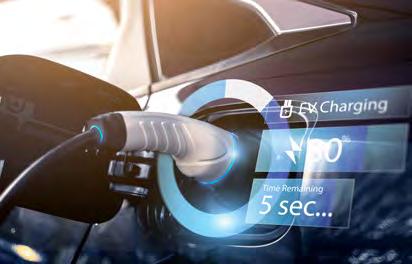
However, how do these states truly compare to the rest of the country when it comes to EV charging stations and ports, and are they leading or lagging behind when adjusting for population and land area?
According to the U.S. Department of Energy’s 2024 data, here’s a breakdown of the number of EV charging stations and ports in Rhode Island, Massachusetts, and Connecticut:
• Rhode Island: 336 charging stations, 774 charging ports
• Massachusetts: 3,228 charging stations, 7,854 charging ports
• Connecticut: 1,175 charging stations, 3,387 charging ports For comparison, let’s take a look at the U.S. averages. Across the entire country, there are 65,837 charging stations and 176,251 charging ports.
Massachusetts
Massachusetts leads the tri-state area with 7,854 charging ports spread across 3,228 stations, making it a key player in New England’s EV infrastructure. Compared to other states, Massachusetts ranks high in terms of charging availability— placing it among the top states nationwide, though still behind EV powerhouse California, which has a staggering 46,877 ports. When factoring in population and land area, Massachusetts performs well:
• Population: 7 million
• Charging Ports per 100,000 people: 112
• Land Area: 10,565 square miles
• Charging Ports per 100 square miles: 74
In terms of both population and land area, Massachusetts exceeds the national average. For comparison, California, the state with the most charging ports, offers 118 ports per 100,000 people, but due to its much larger size, has just 29 ports per 100 square miles. This makes Massachusetts’ density of EV infrastructure particularly impressive.
Connecticut, with 1,175 stations and 3,387 ports, fares well when compared to other states its size. Its proximity to major metropolitan areas and its smaller land area make EV infrastructure more accessible than in many other parts of the country.
• Population: 3.6 million
• Charging Ports per 100,000 people: 94
• Land Area: 5,543 square miles
• Charging Ports per 100 square miles: 61
Compared to the national average of 53 charging ports per 100,000 people, Connecticut is performing better than many states, though it falls behind Massachusetts. In terms of land area, Connecticut also outperforms larger states like Florida (charging density of 55 ports per 100 square miles) and Texas (8 ports per 100 square miles), emphasizing the compact nature of the state’s infrastructure.
Rhode Island, the smallest state by land area, has 336 charging stations and 774 ports, placing it lower in terms of absolute numbers. However, considering its population and small size, it punches above its weight in terms of infrastructure.
• Population: 1.1 million
• Charging Ports per 100,000 people: 70
• Land Area: 1,214 square miles
• Charging Ports per 100 square miles: 64
While Rhode Island’s numbers may seem modest compared to larger states, the availability of ports relative to its size and population density is competitive. States like Wyoming, for instance, only have 261 charging ports across a far larger area, equating to 0.2 ports per 100 square miles. Rhode Island’s infrastructure density is well-suited to its needs, but its smaller population means it naturally falls behind states like Massachusetts in raw numbers.
When looking at the entire U.S., states like California, Florida, and Texas dominate in terms of total number of stations and ports due to their large populations and areas. However, when adjusting for population and land size, states in New England— particularly Massachusetts and Connecticut—are significantly outperforming the national averages.
• National Average (Charging Ports per 100,000 people): 53
• National Average (Charging Ports per 100 square miles): 5.6
In comparison:
• Massachusetts: 112 ports per 100,000 people; 74 ports per 100 square miles
• Connecticut: 94 ports per 100,000 people; 61 ports per 100 square miles
• Rhode Island: 70 ports per 100,000 people; 64 ports per 100 square miles
It’s clear that, despite their smaller sizes, Massachusetts, Connecticut, and Rhode Island have made significant strides in developing an accessible EV charging infrastructure, offering more ports per square mile than many larger states. This is particularly crucial in densely populated areas, where access to charging is a critical component of encouraging EV adoption.
While Massachusetts and Connecticut are leading the charge (no pun intended) in New England, both states still face challenges in expanding their EV infrastructure to meet future demand. As EV sales increase and the transition to electric accelerates, more charging stations will be needed, particularly in rural areas where infrastructure is more sparse.
Rhode Island, while doing well considering its small size, must continue to invest in charging infrastructure if it is to keep up with the growing number of EVs on the road. With a smaller population and limited land area, the state’s capacity to meet EV demand will require innovative planning, possibly focusing on fastcharging networks to maximize efficiency.

Compared to the national leaders in EV infrastructure, New England states still have room to grow. For instance, California has not only the most charging ports but also one of the most developed networks of fast chargers, which are essential for longdistance travel and reducing wait times at charging stations.
Similarly, Florida and New York are rapidly building out their EV infrastructure. New York, for example, has 12,723 charging ports, outpacing Massachusetts significantly. However, these states have larger populations and geographic footprints, which make Massachusetts and Connecticut’s per capita and per square mile charging densities even more remarkable.


When looking at the current state of EV charging infrastructure in Rhode Island, Massachusetts, and Connecticut, these states are doing relatively well, especially compared to national averages. Massachusetts, in particular, stands out as a leader in the region, with a strong network of charging stations that is accessible to much of its population.
Connecticut follows closely behind, but Rhode Island, while maintaining a good density of stations and ports for its size, may need to focus on expanding its charging network as the demand for EVs grows.
As electric vehicles become a larger part of the automotive landscape, these states will need to continue their investments in charging infrastructure to meet future demands, but for now, they can be seen as trailblazers in building a more sustainable future.

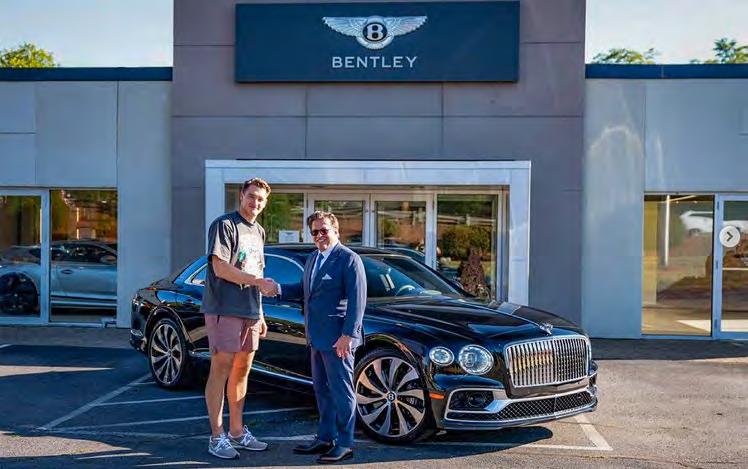
Nikita Zadorov, the formidable defenseman for the Boston Bruins, has always commanded attention both on and off the ice. Known for his aggressive style of play and physical presence, Zadorov's career has spanned several NHL teams, including the Buffalo Sabres, Colorado Avalanche, Chicago Blackhawks, and Calgary Flames. After joining the Bruins in 2024 with a six-year, $30 million contract, Zadorov continues to make his mark as one of the league’s top defensemen.
But Zadorov’s prowess isn’t limited to his on-ice achievements. Recently, he made headlines for another bold move: Picking up a Bentley Flying Spur Edition 8 from Bentley Boston. Just as Zadorov’s reputation for powerful defensive play and precise execution defines his career, his new Bentley reflects the same blend of luxury and performance that has come to be associated with the towering 6'6" defenseman.
Born in Moscow, Russia, Zadorov’s path to the NHL began early. Displaying an extraordinary combination of size, agility, and skating ability, he made waves in the Kontinental Hockey League
(KHL) junior ranks before transitioning to North America. Zadorov was selected 16th overall in the 2013 NHL Entry Draft by the Buffalo Sabres, making an immediate impact as a young, dynamic defenseman.
Over the years, Zadorov's journey took him through multiple teams and roles, from Colorado, where he developed his reputation as a shutdown defender, to Chicago and Calgary, where he further honed his skills. With a career spanning over 500 NHL games, Zadorov's accomplishments include key contributions to the Colorado Avalanche and a memorable NHL hat trick with the Calgary Flames. His most recent move to the Boston Bruins solidifies his place among the league’s elite.
Zadorov’s newest addition to his luxury collection, the Bentley Flying Spur Edition 8, is the perfect complement to his powerful and refined style. Bentley has long been synonymous with elegance and performance, and the Flying Spur is no exception. This special Edition 8 model, equipped with a formidable W12 engine, delivers a staggering 626 horsepower, propelling the car
“Zadorov ’s newest addition to his luxury collection, the Bentley Flying Spur Edition 8, is the perfect complement to his powerful and refined style. Bentley has long been synonymous with elegance and performance, and the Flying Spur is no exception.”
from 0 to 60 mph in just 3.7 seconds. For someone like Zadorov, who thrives on power and precision, this car is a natural fit.
What sets the Flying Spur Edition 8 apart isn’t just its speed but also its luxurious craftsmanship. The interior features meticulously hand-stitched leather, a rotating digital display, and an array of high-tech conveniences designed for both comfort and sophistication. With details like its Mulliner Blackline Specification, which replaces exterior chrome elements with gloss black finishes, the Edition 8 commands attention, much like Zadorov does on the ice.
Bentley Boston, a Herb Chambers Company, where Zadorov picked up his Flying Spur, is one of the premier luxury car dealerships in New England. Known for its bespoke services and commitment to excellence, the dealership has earned a reputation for providing high-end vehicles tailored to the needs of discerning clients. From the moment Zadorov entered the showroom, the team at Bentley Boston ensured that every aspect of his buying experience was as seamless and luxurious as the car itself.
With a roster of clients that includes some of the region’s most notable figures, Bentley Boston stands out for its customer service and attention to detail. Whether it’s customizing a vehicle to suit an individual’s preferences or offering personalized delivery experiences, the dealership continues to lead in luxury automotive sales. As a Bentley fan and a Bentayga owner already, Zadorov was perfect for this partnership with Bentley Boston.
Just as Zadorov’s commanding presence on the ice makes him a key player for the Bruins, the Bentley Flying Spur Edition 8 is a statement of power and elegance on the road. Both Zadorov and his new Bentley are built to perform at the highest level, whether it’s outmuscling opponents in a high-stakes NHL game or
cruising the streets of Boston in one of the world’s most luxurious sedans.
For Zadorov, the Flying Spur is more than just a car—it’s a reflection of his success, style, and the precision with which he approaches both his career and his personal life. As he continues to make his mark with the Boston Bruins, this latest addition to his collection is a fitting testament to his commitment to excellence.
With the Boston skyline as his backdrop and a new season with the Bruins ahead, Nikita Zadorov is ready to take on both the ice and the road in style, proving once again that he knows how to dominate in every arena. Whether he’s at TD Garden or behind the wheel of his Bentley Flying Spur, Zadorov is a force to be reckoned with.




Lamborghini, a brand synonymous with Italian luxury and high-performance vehicles, has once again pushed the boundaries of automotive engineering with the introduction of the Temerario. This supercar follows in the footsteps of the Huracán, but it sets its own course with technological advancements, design evolution, and hybrid power. With over 920 CV from its twin-turbo V8 hybrid powertrain, the Temerario is poised to redefine what a supercar can be. Let’s delve into the design, powertrain, driving dynamics, and pricing to get a comprehensive look at this exciting new machine.
One of the most significant shifts from the Huracán to the Temerario is its powertrain. Lamborghini has replaced the Huracán’s naturally aspirated V10 engine with a twin-turbo V8 hybrid. The decision to move to a V8 came after the brand recognized that increasing displacement or adding more cylinders (a V12) would overlap with the Lamborghini Revuelto. Lamborghini engineers found an innovative way to maintain blistering performance, without enlarging the engine—thanks to twin turbochargers placed in a “hot V” formation.
The 4.0-liter V8 alone produces 789 horsepower (hp), but when combined with the three electric motors that drive the front wheels, total output rockets up to 920 hp. Each of these motors delivers 110 kW of power to the front axle, enabling a sophisticated torque vectoring all-wheel-drive system. The electric power enhances the car’s performance, providing an instant torque boost to eliminate turbo lag, and allowing the car to accelerate from 0 to 62 mph in just 2.7 seconds. Lamborghini claims a top speed of 343 km/h (about 213 mph), with the potential to outperform most vehicles in its segment.
In terms of drivability, the Temerario offers different modes to suit various conditions. For instance, in Drift Mode, the front motors disengage, allowing rear-wheel-drive fun, while EV Mode allows for quieter, emissions-free driving in urban centers. However, with a relatively small 3.8 kWh battery pack, EV Mode is more of a novelty than a practical solution for long distances. It will get you about 6-7 miles of pure electric driving, ideal for sneaking through low-emission zones or short city trips.
Lamborghini’s engineers have worked tirelessly to improve the Temerario’s handling and performance, enhancing both track performance and daily usability. The dual-clutch, 8-speed automatic transmission shifts faster than the 7-speed found in the Huracán, contributing to a more engaging driving experience, especially at high speeds. The inclusion of a flat-plane crankshaft and advanced turbo technology allows the V8 to rev up to an astonishing 10,000

rpm, something unheard of in turbocharged engines of this size. This results in a sound that, according to Lamborghini’s product manager, Paolo Racchetti, will “blow you away,” delivering the visceral, ear-tingling experience that Lamborghini aficionados have come to expect.
A key element of the Temerario’s design is the improvement in aerodynamics, which are 104% more efficient than the Huracán. This increase in downforce ensures the car is glued to the road at high speeds, while its active aerodynamics system automatically adjusts components like the rear spoiler and diffusers to optimize airflow and reduce drag. These aerodynamic enhancements, combined with the lightweight carbon fiber construction, make the car a cornering machine. For track enthusiasts, the optional Alleggerita package reduces the car’s weight by up to 55 pounds by incorporating carbon fiber components like door cards, side skirts, and rear glass.
The Temerario has a sleeker design than the Huracán, though it retains the unmistakable Lamborghini DNA with sharp lines, aggressive angles, and a lowslung stance. The car comes with a range of customizable options, allowing owners to pick from over 400 paint colors. The hexagonal daytime running lights (DRLs) are part of the aerodynamic system, guiding
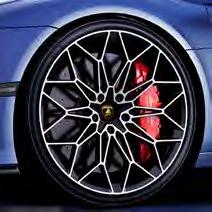

airflow to the side radiators and improving cooling efficiency. According to Mitja Borkert, Lamborghini’s Director of Design, the aim was to create a “cleaner and more mature design,” which contrasts with the wilder Lamborghini Revuelto.
Inside the cockpit, the “Feel Like a Pilot” philosophy takes center stage. Lamborghini has integrated digital and mechanical controls seamlessly, offering the driver a fully immersive, race-inspired experience.
New comfort seats make the Temerario more practical for daily driving, offering 34mm of additional headroom and 46mm of extra legroom compared to the Huracán. Visibility has also been improved, addressing one of the Huracán’s most common criticisms.
The Temerario offers 13 driving modes to adapt to different environments, ranging from track-focused settings like Corsa Plus to more relaxed, everyday driving modes like Strada. The car also introduces three hybrid modes: Recharge, Hybrid, and Performance. In Performance mode, the system unleashes its full 920 hp potential, while Recharge and Hybrid modes balance the V8 engine’s output with electric assistance for a more fuel-efficient drive. Lamborghini’s Lamborghini Vision Unit (LAVU) system brings cutting-edge technology to the Temerario, including features like Telemetry 2.0, which records your driving performance on the track, and the Memories Recorder, which captures moments of your journey. These tools, combined with a fully integrated Sonus faber sound system, ensure that the Temerario offers the most advanced infotainment experience in the brand’s history. Wireless connectivity, real-time navigation updates, and multiple display screens help enhance the in-car experience.
As with most Lamborghinis, customization plays a huge role in the ownership experience. The Temerario starts at $357,621, with an additional $4,000 for destination fees and a gas-guzzler tax. However, adding options can quickly push the price beyond $400,000. For example, the Alleggerita Package—designed to reduce weight for track days—costs an extra $45,000, and certain Ad Personam colors can add upwards of $32,700 to the final bill.
The Lamborghini Temerario is not just an evolution of the Huracán—it represents a revolutionary leap for the brand. With a cutting-edge hybrid powertrain, improved daily usability, and more refined aesthetics, the Temerario manages to retain the essence of Lamborghini’s track-focused performance while making the car more approachable for everyday driving. Though it comes at a steep price, the advanced technology, customization options, and jaw-dropping performance make the Temerario a worthy successor in Lamborghini’s supercar lineup.
For those seeking both raw power and cutting-edge hybrid technology in a package that can handle both daily drives and track days with equal ease, the Temerario sets a new standard.

In the world of luxury cars, Ferrari is often seen as the pinnacle of automotive achievement—a brand synonymous with speed, performance, and exclusivity. For Rhode Island dentist Nick Baldelli, owning a Ferrari is more than just a status symbol; it's the realization of a lifelong passion.
His choice of the 2015 Ferrari FF not only reflects his love for high-performance vehicles but also the practical needs of a growing family, blending his personal interests with his responsibilities.
Nick Baldelli’s journey to Ferrari ownership began long before his career in dentistry. As a political science major, Baldelli initially saw his future elsewhere, but a pivot into the medical field allowed him to pursue a path where he could blend his practical skills with his desire to help others. After completing his dental degree in Boston and a year of residency, Baldelli established a successful practice in Newport, Rhode Island.
But throughout his academic and professional years, his passion for cars remained strong. His automotive history reads like a who’s who of desirable vehicles, starting with a Toyota Land Cruiser as a teenager, moving through several Jeep models, and eventually to the high-performance Porsche 911 GT3. Each car reflected different stages of his life—from his days as a student to a rising professional and eventually to a family man.
At his wedding, Nick’s best man’s speech reflected this passion in a humorous way. Rather than talk about ex-girlfriends, his best man recounted Nick’s long list of “exes”—his former vehicles. This running joke exemplifies just how deeply Baldelli’s love for cars runs. As Nick puts it: “The GT3 was my dream car. My best men

even wrote their wedding speech around my ex-cars. That’s how deep the passion goes.”
With the arrival of his first child on the horizon, Baldelli recognized that his Porsche 911 GT3—a two-seater sports car—was not going to meet the practical needs of a growing family. He began looking for a vehicle that would offer both Ferrari’s performance and enough space for his wife and child to join him on his driving adventures. His search led him to the 2015 Ferrari FF, a car that blends high-performance capabilities with family practicality.
Introduced in 2011, the Ferrari FF was a game-changer for the brand. It was Ferrari’s first production car with four-wheel drive and offered seating for four adults—rare in the world of highend sports cars. Powered by a 6.3-liter V12 engine with 651 horsepower, the FF can go from 0 to 60 mph in just 3.7 seconds. For Baldelli, this performance was essential, but what made the car truly stand out was its practicality. “It was a race car for the road. Every time I went for a ride, it was a real event. I wanted my wife and kids to be a part of these car ‘events’ that I love.”
In November, Baldelli traded in his Porsche for the 2015 Ferrari FF. Not only did the FF offer the space he needed, but it also provided financial benefits. The trade-in reduced his car payments, a surprising fact given Ferrari’s reputation for exclusivity. As



Baldelli notes, “Despite the FF’s higher perceived status, I actually reduced my car payments compared to the Porsche, which had been more expensive when I purchased it at a peak in the used car market.”
Owning a Ferrari isn’t just about the driving experience for Baldelli—it’s about sharing his love for cars with his family. “I wanted my wife and kids to be a part of these car ‘events’ that I love,” Baldelli says. The Ferrari FF, with its four seats, allowed him to do just that. He fondly recalls moments at local car shows: “The GT3 was always admired, but nothing got more head turns than

when I’d pull a newborn out of the back seat and a stroller from the trunk of my Ferrari. Everyone gets a kick out of it, and I get more thumbs up than ever before.”
His son, Logan, is already showing signs of following in his father’s footsteps. At nearly two years old, Logan has developed his own routine when riding in the Ferrari or in Nick’s daily driver, a Jeep Grand Cherokee Trackhawk: “Whenever we’re in the Ferrari or in my Jeep Trackhawk, he gives me the signal: ‘Set, Go!’ and lets out the biggest giggle and smile.”
Ferrari ownership, especially of a nine-year-old model like Baldelli’s FF, does come with its challenges—particularly in the realm of maintenance. To mitigate risks, Baldelli purchased a warranty and a maintenance package to cover any unexpected repairs. One early challenge came when the car’s battery failed within six months of ownership. Baldelli managed the repair himself, saving on the service charges that are often associated with Ferrari maintenance.
Despite these minor hiccups, Baldelli has fully embraced driving the FF. In his first year of ownership, he has put nearly 4,000 miles on the car—a sharp contrast to the typical supercar owner who may limit driving to preserve resale value. “It’s about the experience,” Baldelli says. “I want to drive my car, not just look at it.”
While his Ferrari FF plays a significant role in Baldelli’s life, it exists alongside his demanding career as a dentist and his responsibilities as a husband and father. Since purchasing his practice in Newport in 2020, Baldelli has navigated the challenges of running a successful business in a competitive market.
Yet despite these pressures, Baldelli finds time to indulge his automotive passion. Whether it’s taking his Ferrari to Cars and

Coffee events or simply going for a drive with his family, he balances work, life, and passion in a way that few people manage to achieve.
For Baldelli, choosing the Ferrari FF wasn’t just about fulfilling a childhood dream—it was a calculated decision that fit both his family’s needs and his desire for high-performance driving. In a market where luxury cars often require compromises on practicality, the Ferrari FF stands out as a unique option. As Baldelli’s story demonstrates, passion and practicality don’t have to be mutually exclusive. Sometimes, the right choice is the one that lets you have both.

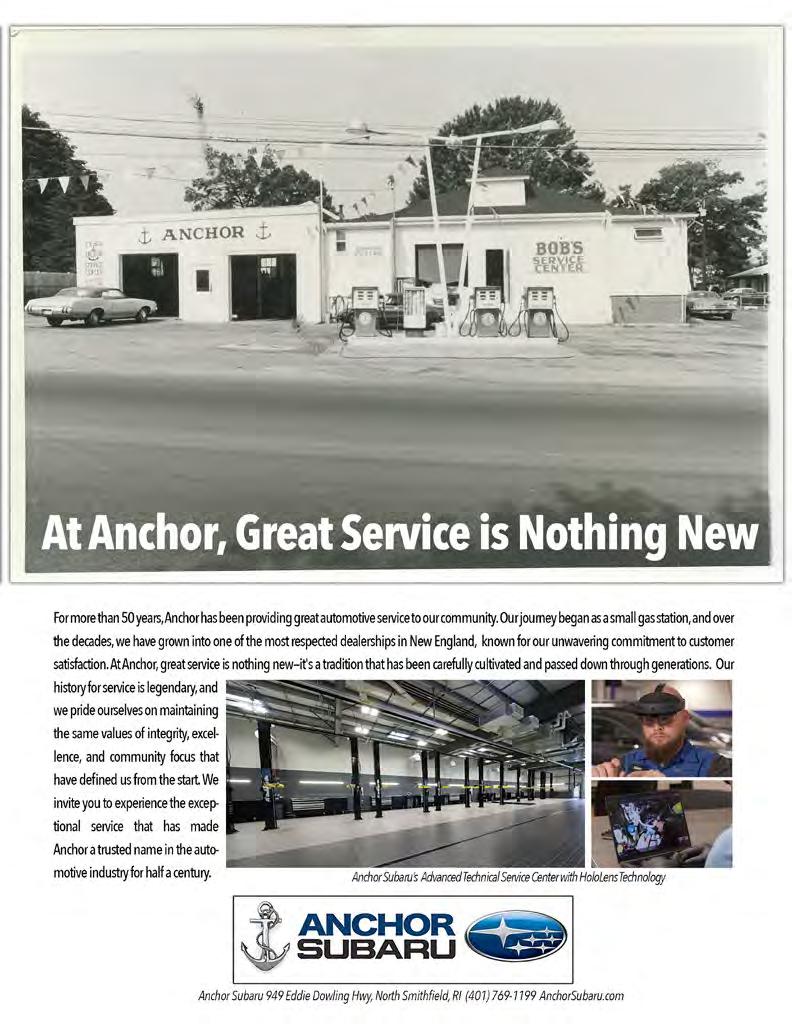







Born: 1966

Resurrected: 2009
Final Year: 2024


With a heavy heart, we bid farewell to the Chevrolet Camaro, a true icon of American muscle, whose storied life spanned nearly six decades. Born in the heated battles of the pony car wars of the 1960s, the Camaro quickly became a symbol of performance, style, and the thrill of driving. As the final year of production comes to a close, we reflect on the legacy of this beloved car, which has left an indelible mark on the automotive world.
With its sleek design, powerful engines, and a name that exuded confidence, the Camaro captured the hearts of enthusiasts from the start. It was offered in a variety of trims, from the base model to the high-performance Z/28 and SS versions, each offering a unique blend of style and substance. The Camaro quickly established itself as a fierce competitor on the street and the track, earning a reputation for being as capable as it was beautiful.
The Camaro’s first generation ran from 1967 to 1969, with the iconic 1969 model becoming a benchmark in automotive design. This car epitomized the muscle car era with its aggressive stance, bold lines, and raw power, featuring engine options that included the legendary 396 V8 and the high-revving 302 V8 in the Z/28. The Camaro’s success was more than just sales—it became a cultural icon, featured in movies, music, and in the garages of car enthusiasts across America.


The Chevrolet Camaro was first introduced in 1966 as a 1967 model, a direct response to Ford’s wildly successful Mustang.
The Camaro’s journey wasn’t without its challenges. As the muscle car era waned in the 1970s and the focus shifted towards more fuelefficient vehicles, the Camaro evolved to adapt to changing times. The second, third, and fourth generations of the Camaro each brought new designs and innovations, but by 2002, the Camaro’s future seemed uncertain. That year, Chevrolet discontinued the Camaro, citing declining sales and shifting market demands. But the Camaro’s story was far from over. In 2009, Chevrolet resurrected the Camaro, reintroducing it to a market that had rediscovered its love for American muscle. The fifth-generation Camaro was a modern reinterpretation of the classic design, blending retro styling cues with contemporary performance and technology. It was an instant hit, reigniting the passion of Camaro


fans and introducing a new generation to the thrill of driving a powerful, rear-wheel-drive coupe. The Camaro returned to its roots with powerful V8 engines, including the mighty 6.2-liter LS3 in the SS model, and a renewed focus on performance.
The sixth generation, launched in 2016, took the Camaro’s performance to new heights. Built on GM’s Alpha platform, the sixth-generation Camaro was lighter, more agile, and more powerful than ever before. It featured a range of engines, from the turbocharged four-cylinder to the naturally aspirated V6 and the fire-breathing LT1 V8. The Camaro ZL1, with its supercharged 6.2-liter V8 producing 650 horsepower, became one of the most formidable performance cars on the market, capable of outpacing far more expensive European rivals on the track.
As we entered 2024, it became clear that the Camaro’s time was coming to an end. Chevrolet announced that this would be the final year of production, marking the end of an era for the Camaro and for American muscle cars. The 2024 Camaro was offered in several trims, each a testament to the car’s legacy of performance and style.
• Camaro LS and LT: The entry-level trims continued to offer the perfect blend of style and performance, with the turbocharged 2.0-liter four-cylinder engine delivering a punchy 275 horsepower. For those who wanted a bit more power, the 3.6-liter V6 was available, producing 335 horsepower.
• Camaro SS: True to its heritage, the SS trim was powered by the iconic 6.2-liter LT1 V8, producing 455 horsepower. The SS offered exhilarating performance, with the ability to sprint from 0 to 60 mph in just over four seconds.
• Camaro ZL1: The pinnacle of Camaro performance, the ZL1 continued to dominate with its supercharged 6.2-liter LT4 V8, delivering an astonishing 650 horsepower. The ZL1 was the ultimate track weapon, equipped with performance upgrades like Magnetic Ride Control, Brembo brakes, and a 10-speed automatic transmission.
• Special Editions: To commemorate the final year, Chevrolet offered special edition models, including the “Collector’s
Edition” which featured unique badging, special paint options, and upgraded interior materials, ensuring that the last Camaros off the production line would be true collector’s items.
As the Camaro exits the stage, it leaves behind a legacy that will be remembered by enthusiasts for generations to come. The Camaro is survived by other models in Chevrolet’s lineup that carry the torch of performance:
• Chevrolet Corvette: The Corvette, America’s sports car, continues to push the boundaries of performance and technology with its mid-engine design and world-class capabilities.
• Chevrolet Tahoe and Suburban: While not muscle cars, the Tahoe and Suburban remain icons in their own right, representing the best in full-size SUVs with performance variants that showcase Chevrolet’s commitment to power and capability.
• Chevrolet Silverado: The Silverado remains a cornerstone of Chevrolet’s lineup, offering robust performance and versatility. The upcoming Silverado EV represents Chevrolet’s vision for the future of performance in a rapidly changing automotive landscape.
As we say goodbye to the Chevrolet Camaro, we reflect on the impact it has had on the automotive world and on the hearts of car enthusiasts everywhere. The Camaro was more than just a car—it was a symbol of freedom, power, and the joy of driving. Though its production has ended, its legacy will live on in the memories of those who drove it, admired it, and dreamed of owning one.
The Camaro’s spirit will endure, not just in the surviving Chevrolet models, but in the stories, the culture, and the passion it inspired. It was a car that truly made an impression, from its roaring engines to its sleek lines, and it will forever be remembered as one of the greats in automotive history.
Rest in peace, Chevrolet Camaro.
Art cars are more than just vehicles; they are dynamic, mobile canvases where artists explore identity, creativity, and the intersections of art and technology.
While BMW’s famed Art Car Project stands as the most iconic and long-standing art car initiative, many other manufacturers and artists have left their mark on this unique form of expression. From famous artists working with luxury automakers to independent creators reshaping old sedans, the art car movement is as diverse as the artists themselves.
The BMW Art Car Project, launched in 1975, remains the gold standard for manufacturer-backed art cars. Its most celebrated creations include:
• Alexander Calder (1975, BMW 3.0 CSL): Calder’s piece, the first in the series, was a brightly colored, geometric design. His style of primary colors and sweeping curves gave the BMW a sense of movement and energy, fitting for a car designed for racing.
• Andy Warhol (1979, BMW M1): Warhol’s M1 is one of the most famous in the series. Unlike other artists, Warhol painted the car himself, applying bold, broad strokes of vivid color. He stated that the brushstrokes themselves represented speed.
• Roy Lichtenstein (1977, BMW 320i): Lichtenstein brought


his signature pop art style to this project, using comic book-like dots and thick lines to depict the flow of road and scenery on the car’s surface. He famously said, “I wanted the car to appear as if it were driving along a road.”
• Jeff Koons (2010, BMW M3 GT2): Koons embraced modernity, using a rainbow of bright colors with digital precision. His work emphasized dynamism, with the paint job looking like the car was moving at high speed even when standing still.
BMW’s legacy of collaboration with artists remains unparalleled in terms of both scale and prestige. Yet, BMW is far from the only company that has embraced the art car concept.
While Porsche has not cultivated an official art car series like BMW, they have been a favorite canvas for many independent artists. One notable example is Richard Phillips’ Porsche 911 RSR (2019). This art car featured Phillips’ signature hyper-realistic paintings, including vivid portraits of women. The car made its debut at the 24 Hours of Le Mans, merging fine art with highperformance motorsport.
Porsche has also been central to more grassroots movements. Artist Daniel Arsham, known for blending modern and decayed aesthetics, created an eroded-looking 1986 Porsche 911 Turbo. His “Future Relic” series on this car gives it a fossilized look, as if it had been unearthed from the distant future.
Mercedes-Benz, too, has dipped its toes into the art car world. Daimler’s Mercedes-Benz 300 SL served as the base for Swiss artist Rainer Schlegelmilch’s piece titled “The Flaming Car,” created in the late 1990s. Schlegelmilch painted the 300 SL in a vivid flame motif, adding depth and a surreal sense of motion to an already-iconic car.

Additionally, the Mercedes-Benz CLA Street Art Edition (2013) saw collaborations with street artists like Mr. Brainwash, who added his signature colorful graffiti motifs to a CLA sedan. Though a marketing stunt, it spoke to the brand’s willingness to fuse urban creativity with high-end automotive engineering.
No discussion of art cars would be complete without mentioning the Volkswagen Beetle, often seen as the quintessential canvas for independent creators. In the 1960s, the Beetle became synonymous with counterculture, with thousands of personalized, hand-painted designs. The car’s approachable shape and the fact that it was affordable made it a favorite for artists and activists alike.
Perhaps the most famous Beetle art car is “The Love Bug”, also known as Herbie from the Disney films, featuring a whimsical racing stripe and number 53. Although fictional, Herbie reflects the Beetle’s role in American pop culture and its frequent role in art car projects.
In a more artistic vein, Harrod Blank, a prominent figure in the modern art car community, transformed his Volkswagen Beetle into a rolling exhibition of creativity. His 1965 VW Beetle, dubbed “Camera Van,” is covered in working cameras and reflective surfaces, capturing the public’s fascination with art cars as interactive, public-facing pieces of art.


In the U.S., art cars are not confined to European luxury brands. Lowriders, especially in Chicano culture, represent one of the most intricate and historically rich forms of art car expression. These cars, typically American classics from the 1950s or ‘60s like Chevrolet Impalas or Cadillacs, are often adorned with custom paint jobs, elaborate murals, and hydraulic systems that allow them to “dance.”
Artists like Mister Cartoon, a legendary tattoo and mural artist from Los Angeles, have been heavily involved in the lowrider scene. His custom designs—intricately detailed and full of cultural symbolism—have made lowriders a staple in the art car community. The cars themselves serve as tributes to family, culture, and identity, making them moving works of art.
Outside the corporate and luxury sphere, the annual Burning Man Festival in Nevada has become a global center for DIY art cars. At Burning Man, the cars—known as “Mutant Vehicles” often take fantastical forms, from a giant, moving octopus to a life-sized pirate ship on wheels. These cars are made from scratch, repurposed from old vehicles or built onto the framework of buses, vans, and trucks. Artists like Tom Kennedy, who was pivotal in the early art car movement at Burning Man, transformed vehicles into surreal, mobile sculptures that inspire wonder and reflection.
Burning Man emphasizes individual expression, and its participants create cars as art pieces not for profit or fame but to contribute to the festival’s communal and creative atmosphere. Art cars at Burning Man have become legendary, showcasing the most extreme and inventive side of the art car world.
The world of art cars is a unique crossroads where creativity meets mechanics, and cars are no longer simply a means of transportation but a platform for artistic exploration. From BMW’s high-profile collaborations with legendary artists like Calder and Warhol to the DIY ingenuity of Burning Man participants, the art car movement demonstrates how powerful and personal the automobile can be as a medium. Brands like Porsche, Mercedes-Benz, and Volkswagen have also been integral in supporting or inspiring the art car movement, showing how automakers and artists alike continue to blend functionality with artistic brilliance.

In the digital age, convenience is king. From groceries to gadgets, virtually everything can be purchased with a few clicks. The auto industry is no exception, with a plethora of third-party shopping services promising to simplify the car-buying process and secure the best deals.
However, beneath the surface of this apparent convenience lies a financial dynamic that can significantly impact the final price consumers pay.
Third-party auto shopping services like TrueCar, Edmunds, and Kelley Blue Book have become household names, offering a seemingly seamless way to compare prices, read reviews, and even secure financing. These platforms market themselves as impartial advisors, helping buyers navigate the often opaque world of car sales. They promise to eliminate haggling and deliver transparency, but the reality is more complex.
What many consumers don’t realize is that most of these thirdparty services charge dealerships for every lead generated through their platforms. These fees can range from $300 to $400 per car sold, a cost that dealerships inevitably factor into their pricing strategies. In essence, while the consumer may feel they’re getting a great deal facilitated by an impartial third party, the dealer is absorbing additional costs that can indirectly be passed on to the buyer. In addition, those third parties are anything but impartial.
They sell the lead (you) to the dealership that’s willing to pay. You might well get a better deal at a better dealer who’s closer and more convenient. But you’ll never get that information if the dealer isn’t willing to pay that third party for your information.


“ What many consumers don’t realize is that most of these third-party services charge dealerships for every lead generated through their platforms. ”
The promise of securing the best possible deal is a major selling point for third-party services. However, the hidden fees these companies charge dealerships can create a paradox. The dealership, aiming to maintain profitability, may adjust their pricing or add hidden costs elsewhere to offset the lead generation fees. This means that the “great deal” highlighted on the third-party platform might not be as advantageous as it appears.
The concept of transparency is central to the appeal of third-party services. They provide detailed price breakdowns, comparisons, and market insights. Yet, this transparency often doesn’t extend to the fees they impose on dealerships. Consumers might see a vehicle priced attractively on a third-party site, but they are not privy to the underlying costs that influenced this price.
Furthermore, dealerships might prioritize customers who come through other, less costly channels, offering them better deals to avoid the lead generation fees. This creates an uneven playing field, where direct customers might secure better deals than those routed through third-party platforms.
For consumers, understanding the financial dynamics at play is crucial. Here are some strategies to ensure you get the best deal:
1. Do Your Homework:
Utilize third-party platforms for initial research. They are valuable tools for comparing models, understanding market prices, and reading reviews. However, don’t stop there.
2. Engage Directly with Dealerships
After identifying a few models, reach out to local dealerships directly. Inquire about their best price and mention you are aware of the third-party fee structure. This transparency can often lead to better negotiations.
3. Understand the Fees:
Be aware of potential hidden costs and scrutinize the final price breakdown to ensure there are no unexpected extras.
4. Leverage Multiple Quotes:
Obtain quotes from multiple dealerships, both through thirdparty services and direct inquiries. If you have a lower third party quote, show it to your local dealer and they’ll usually match it or beat it.
As the auto industry continues to evolve, so too will the dynamics between third-party services, dealerships, and consumers. Some forward-thinking dealerships are already adopting no-haggle pricing and direct-to-consumer sales models, aiming to provide transparency and eliminate the middleman.
For now, though, consumers must navigate the current landscape with a critical eye. While third-party auto shopping services offer some tools and insights, being aware of the underlying costs and their impact on final pricing is essential. By doing so, buyers can ensure they are truly getting the best deal, not just the bestmarketed one.
In a world where convenience often comes with hidden costs, it’s essential for consumers to be informed about the dynamics of auto shopping. While third-party platforms can be useful tools for research, direct communication with your local dealer brings better results. Local dealerships value your business not just for the sale, but for the ongoing relationship, including service and maintenance. Plus, the awkwardness of bringing your car to a nearby dealership with a distant dealer’s logo can be avoided. Many local dealers are willing to match or even beat the prices offered by third-party services—you just have to ask. So next time you’re shopping for a new car, don’t hesitate to reach out directly to your local dealership. It could save you more than just money.
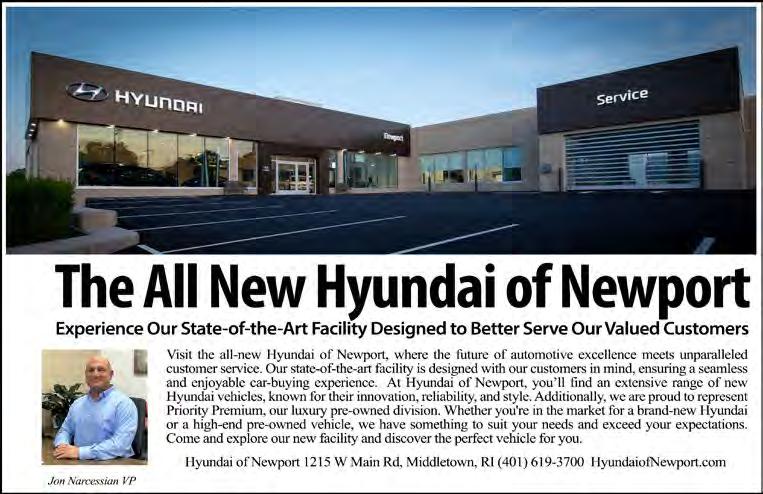




When it comes to car buying, the standard belief is that a car’s value immediately depreciates as soon as it leaves the dealership lot. Typically, the appeal of buying a used car is the savings it provides, offering a more economical option compared to a brand-new vehicle. (Images courtesy of Hoffman Nissan.)
However, in the niche world of high-performance sports cars, particularly the Porsche 911 GT3 RS, the conventional rules do not apply.
Consider a 2024 Porsche 911 GT3 RS, currently available at Hoffman Nissan in Connecticut. This vehicle, with just 2518 miles on the odometer, is listed for a jaw-dropping $449,950—a substantial increase over its original sticker price of $315,390. To those unfamiliar with the world of high-performance vehicles, this may appear to be an anomaly. However, this pricing is emblematic of the unique supply-and-demand dynamics that exist within the market for limited-edition sports cars.
The Porsche 911 GT3 RS is far from an ordinary sports car. Built for the track and engineered with precision, this machine is produced in limited numbers, making it a highly coveted piece of automotive engineering. The 2024 model in question is equipped with the sought-after Weissach Package, an option that adds over $33,000 to the car’s base price. In addition, features like Porsche Ceramic Composite Brakes (PCCB) with yellow calipers, a front axle lift system, and a variety of custom options further increase the car’s overall value.
This particular GT3 RS also comes with the full body paint protection film. The car’s Black exterior paired with a black
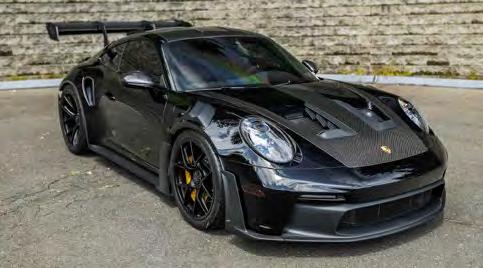


leather/Race-Tex interior featuring GT silver stitching, along with wheels finished in satin black, make for a striking visual statement.
The phenomenon of used Porsche 911 GT3 RS models selling for higher prices than new ones is primarily driven by the forces of supply and demand. Porsche deliberately limits production of the GT3 RS to ensure its exclusivity. Additionally, Porsche does everything it legally can to prevent dealers from selling rare models above the Manufacturer’s Suggested Retail Price (MSRP). Consequently, long waiting lists develop for new models, and enthusiasts or collectors who miss out on buying new turn to the used market. Here, competition is fierce, often pushing prices well above the original MSRP.
Hoffman Nissan’s listing underscores the economic oddity of this market. The car was initially sold by Porsche of Lehigh Valley and comes with a clean title and Carfax report, further enhancing its appeal. Essentially brandnew, with minimal miles and packed with high-end options, this particular 911 GT3 RS represents a rare opportunity for collectors or serious driving enthusiasts.
Moreover, Porsche Financial Services is offering special financing options for up to 72 months to qualified buyers, making the purchase even more attractive despite the premium price tag.
The case of this 2024 Porsche 911 GT3 RS is not unique but rather part of a broader trend seen across limited-production, highperformance vehicles. For many buyers, these cars are not merely transportation; they are investments, often appreciating in value over time, particularly when they are wellmaintained and have low mileage.
This trend upends traditional car-buying wisdom, highlighting the specific market dynamics of luxury, performance, and collectible vehicles. In the end, while most cars lose value as soon as they are driven off the lot, the Porsche 911 GT3 RS defies this norm—proving that, for the right buyer, purchasing used may actually come with a higher price tag, but it’s a cost many are willing to pay for automotive perfection.
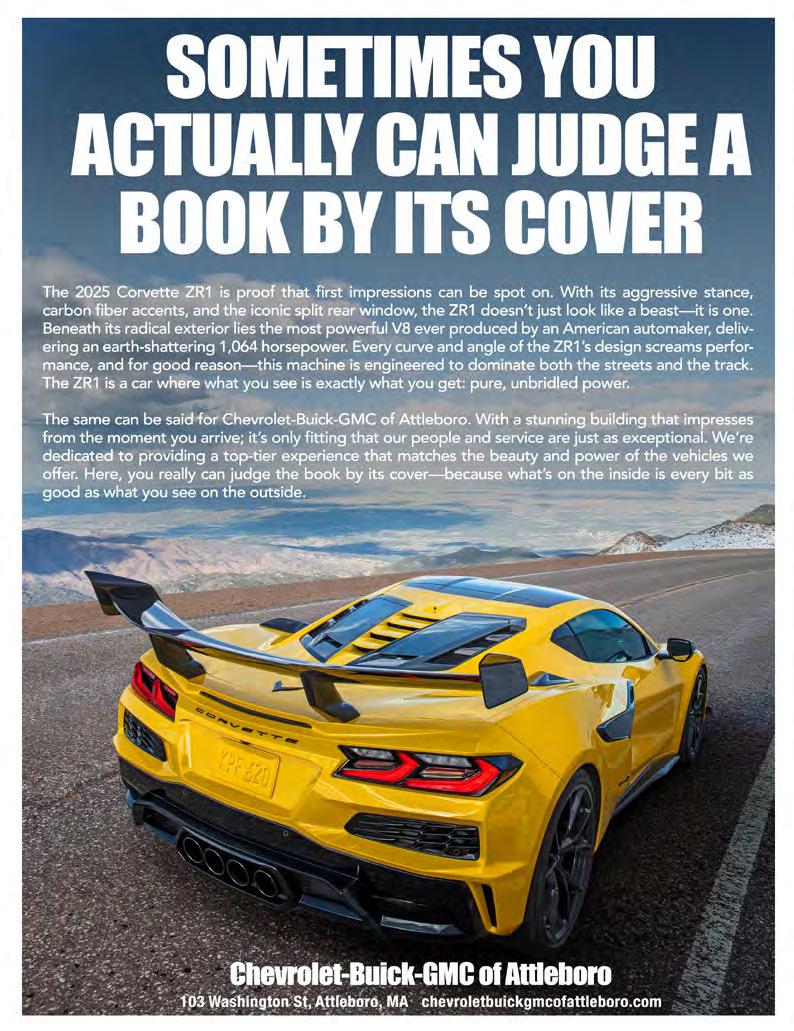


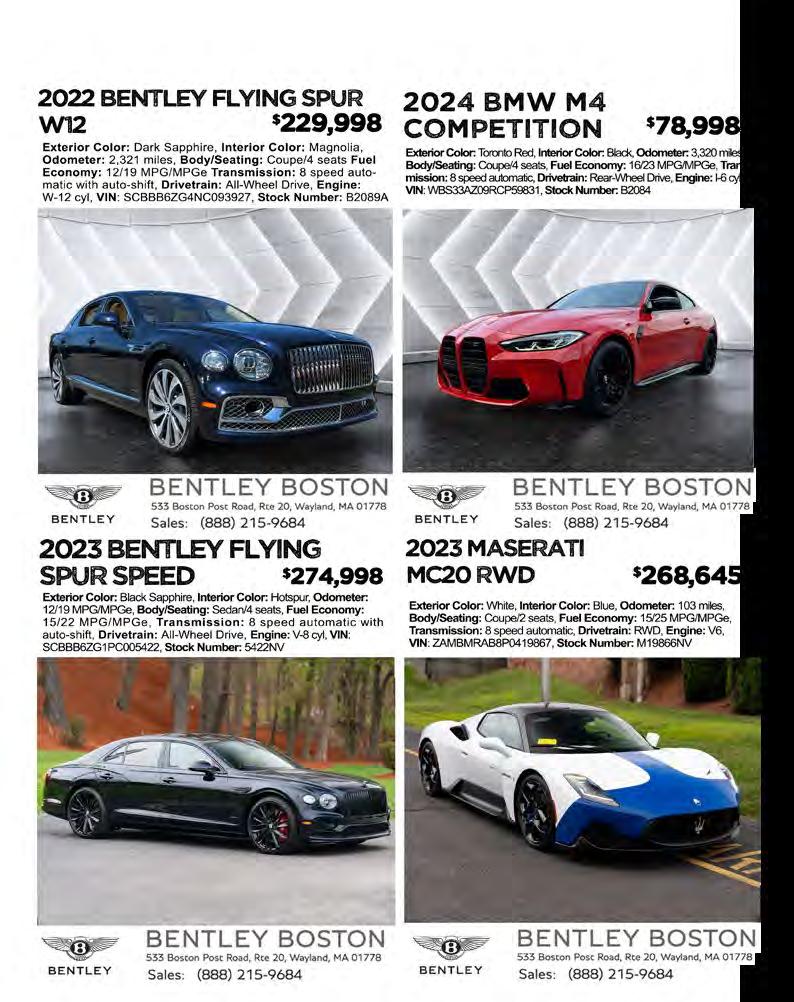





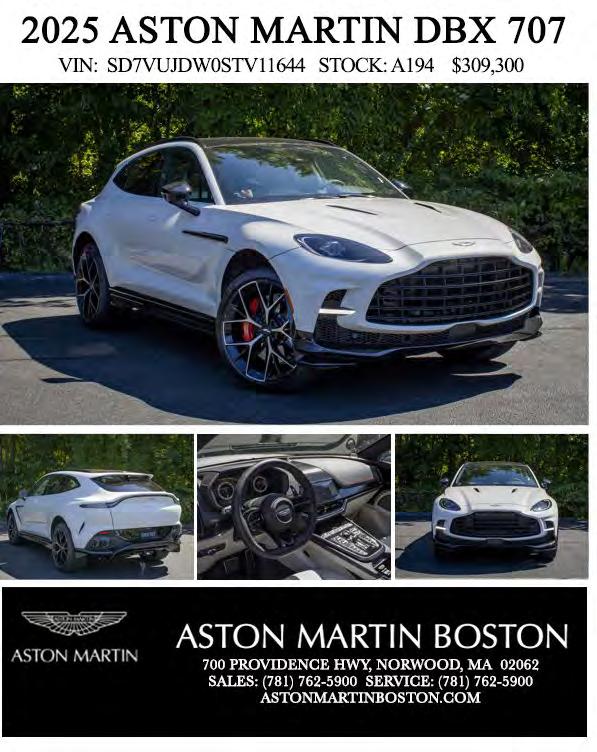





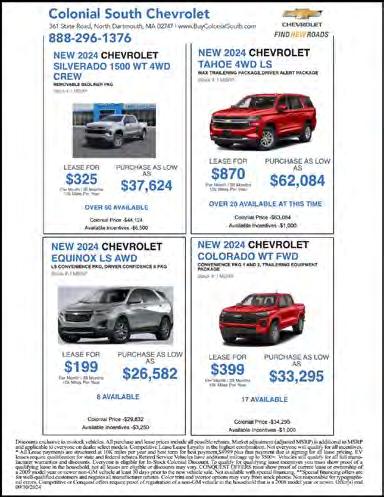




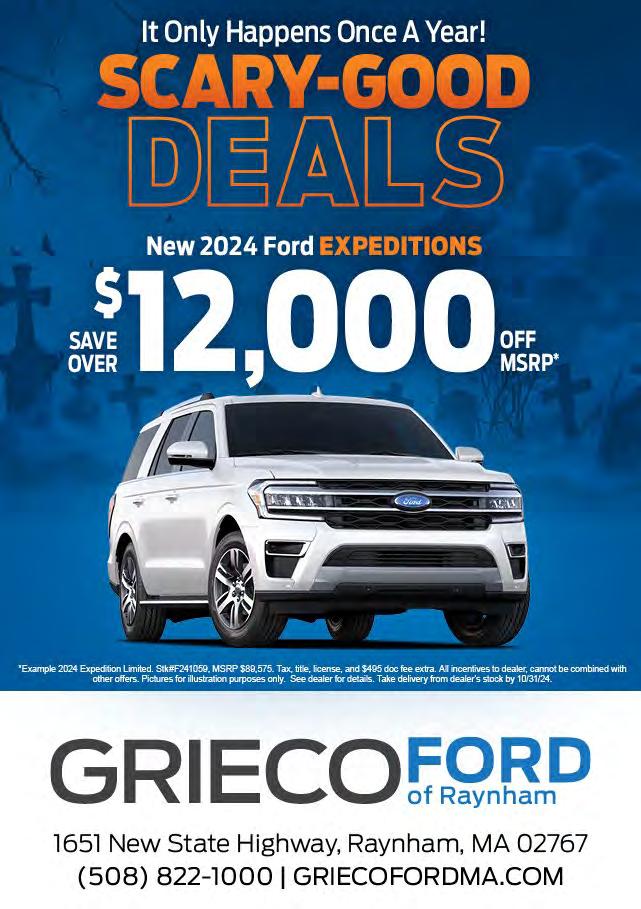


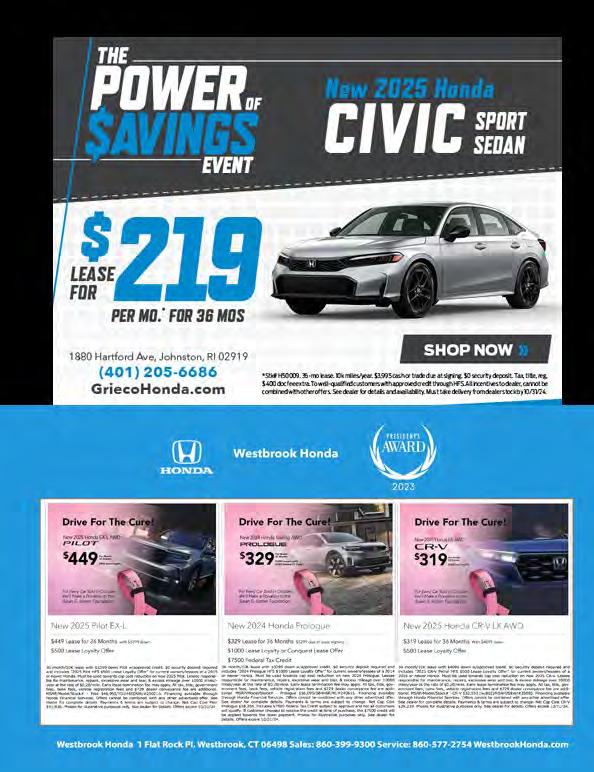







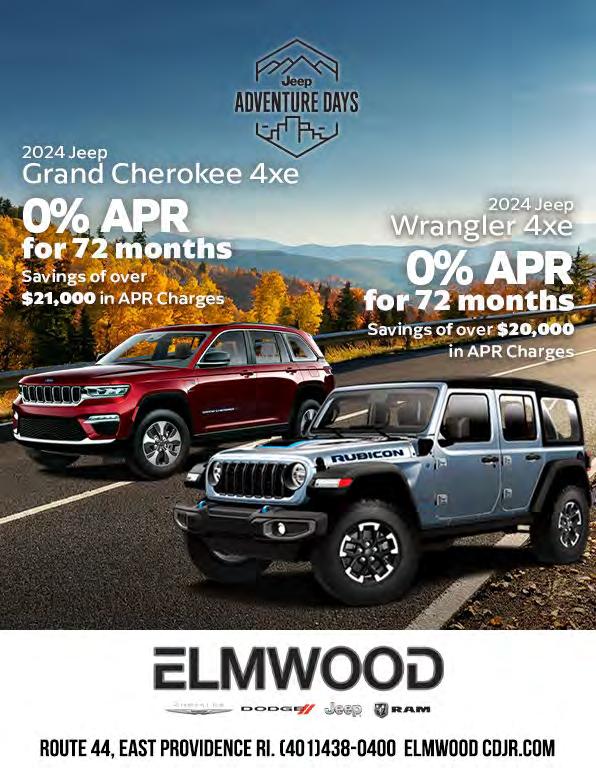


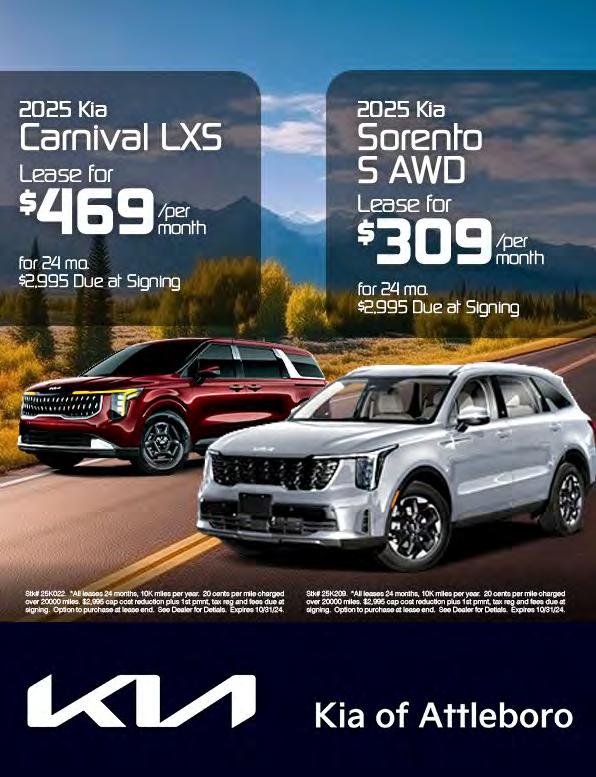


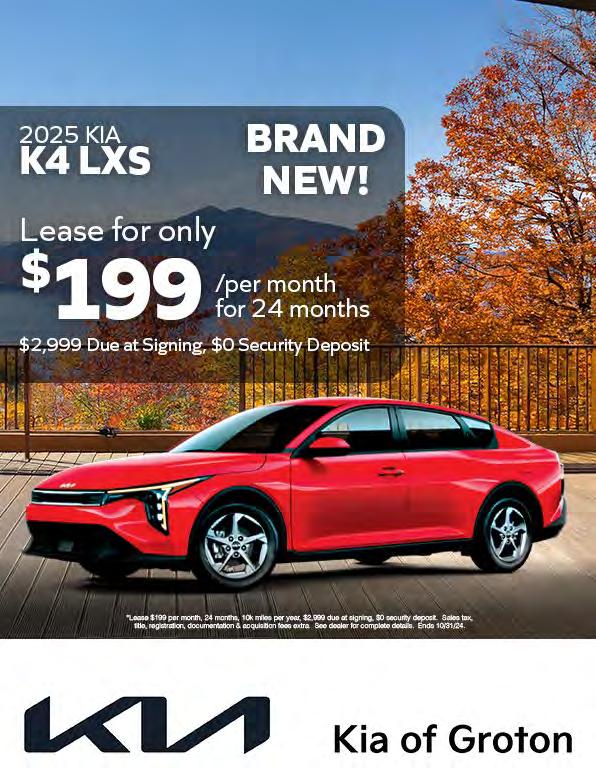





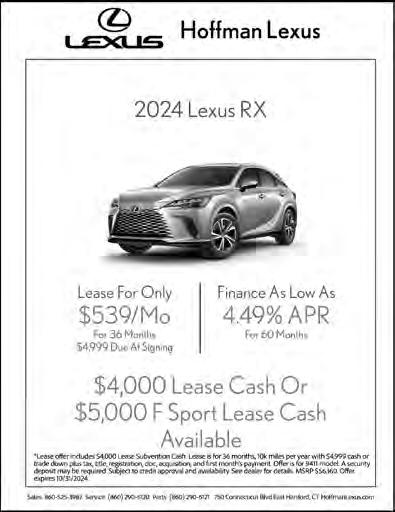
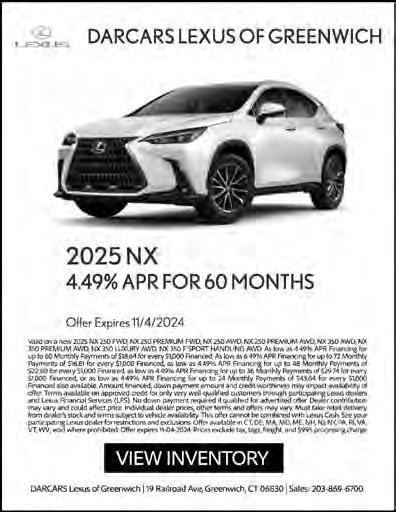





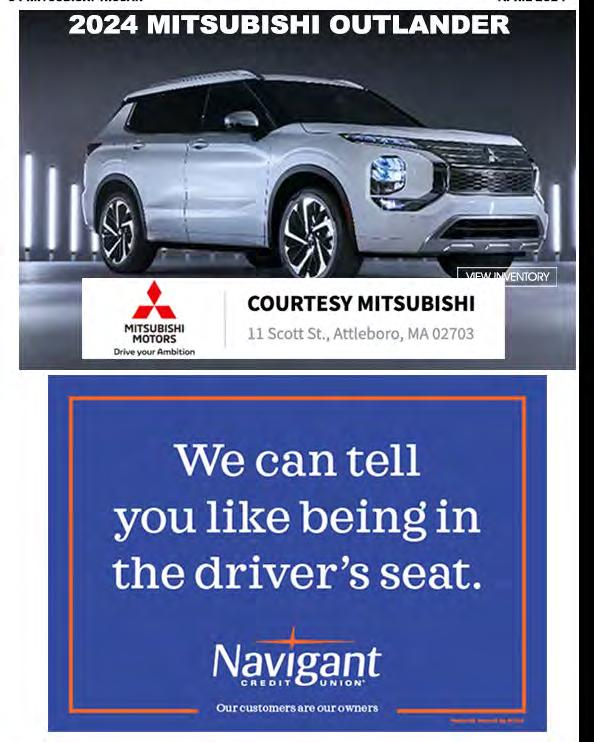





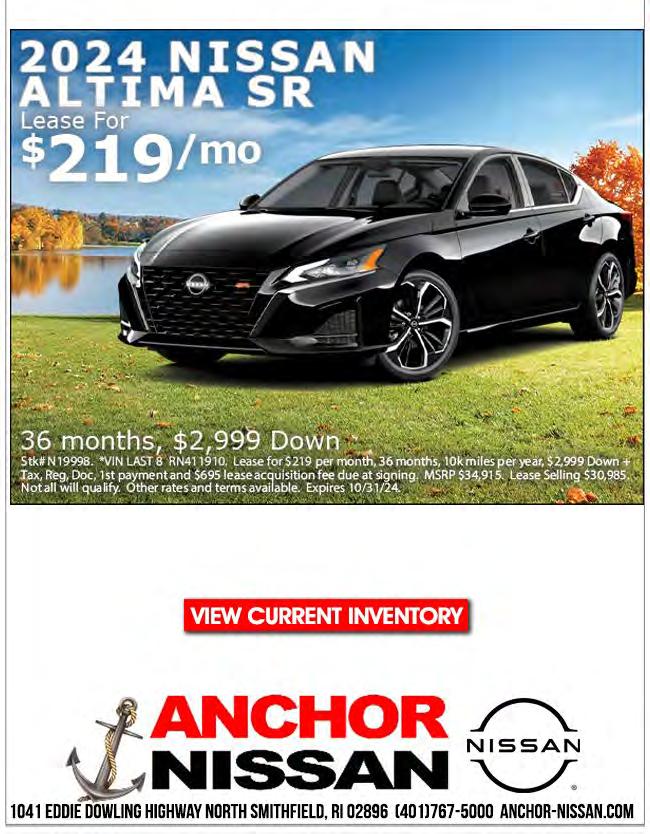


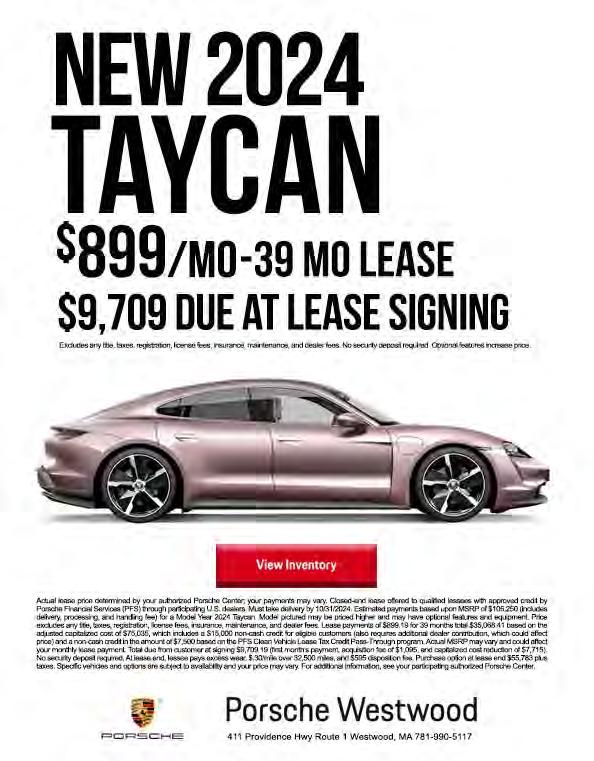

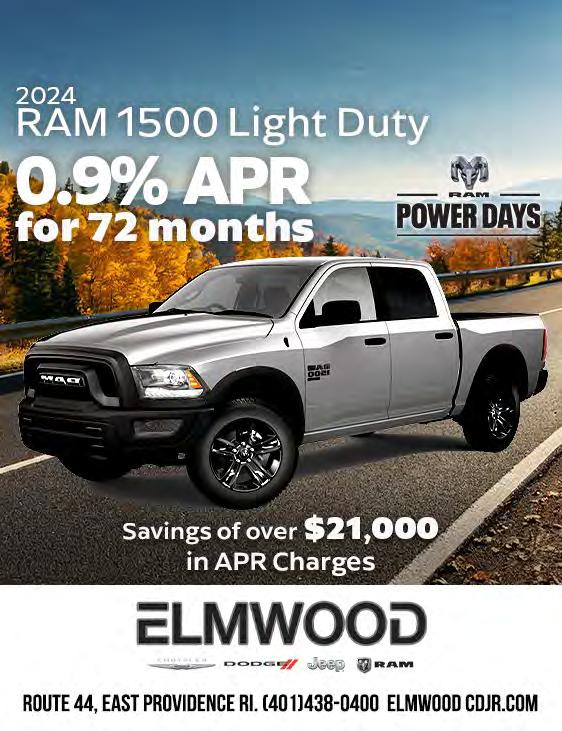
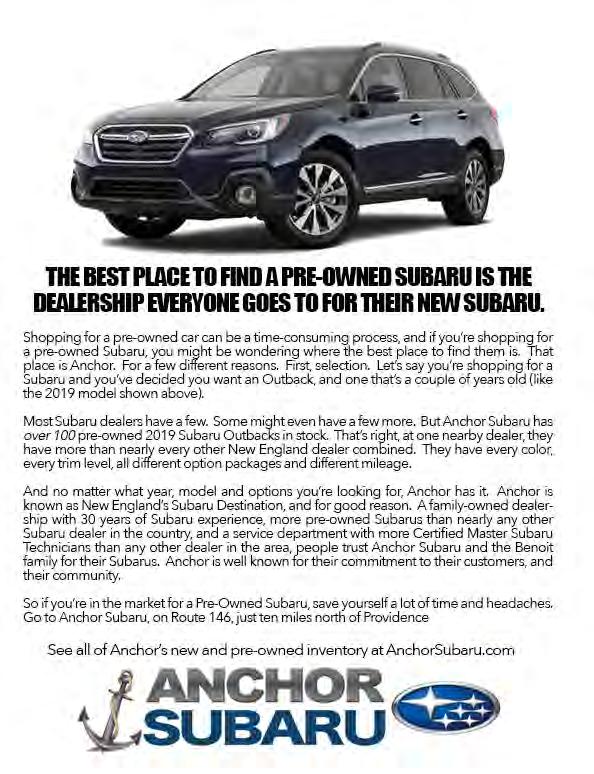


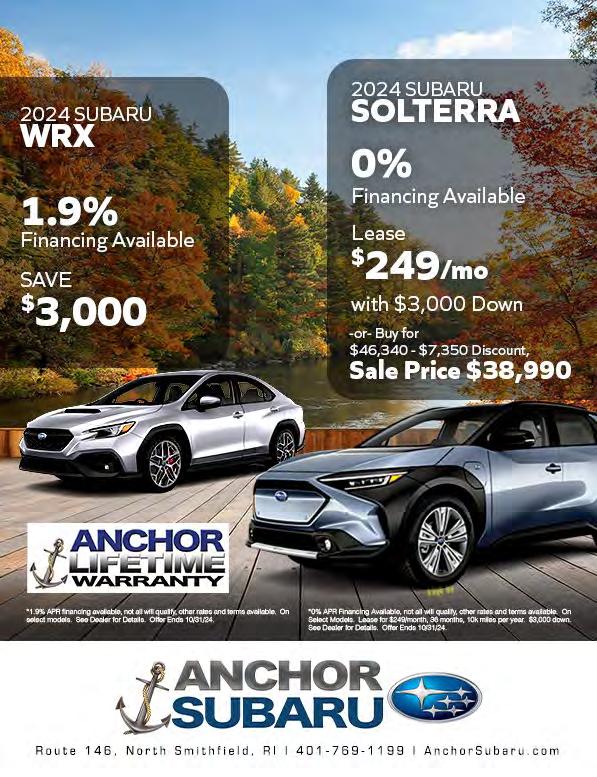

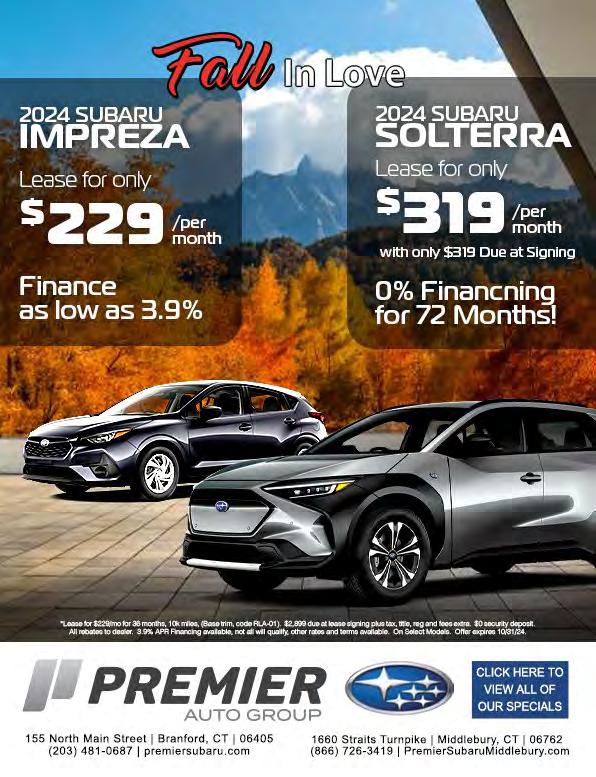



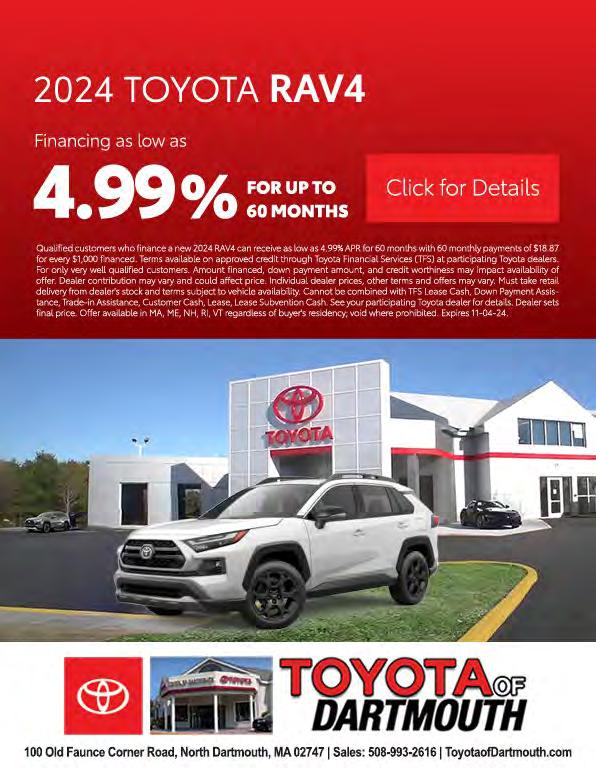
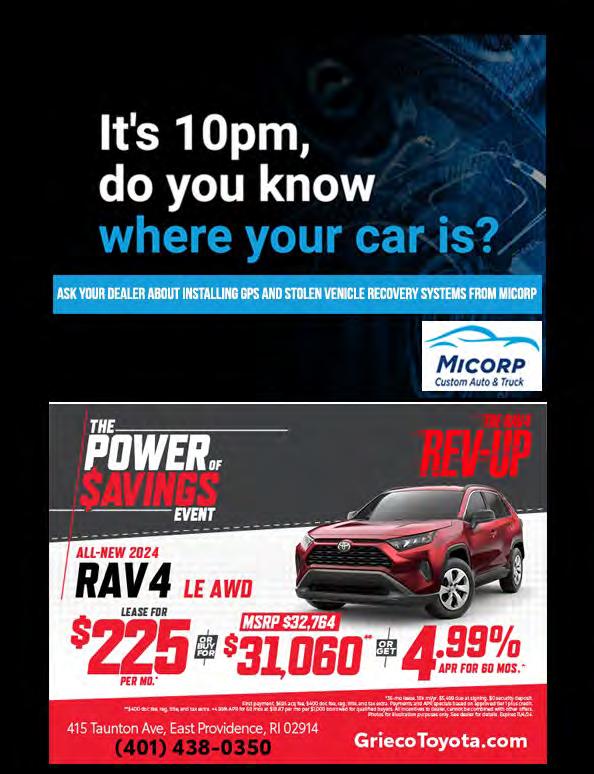





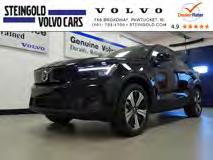


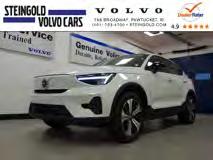








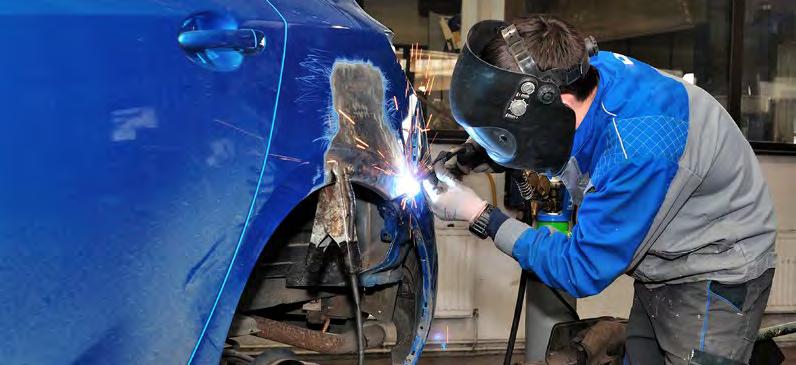
In the bustling world of auto body repair, few names stand out as much as Elmwood Auto Body in Warren, Rhode Island.
In the bustling world of auto body repair, few names stand out as much as Elmwood Auto Body in Warren, Rhode Island. Owned and operated by the L’Archevesque family—who have been a staple in the auto industry for over 50 years with their dealership, Elmwood Chrysler Dodge Jeep Ram (CDJR)— Elmwood Auto Body is a prime example of how experience, reputation, and cutting-edge technology can come together to deliver exceptional results for customers.
The L’Archevesque family’s roots in the automotive business run deep, with their family-owned Elmwood CDJR being a trusted name in the Rhode Island community for decades. This legacy of trust and service carries over into their auto body shop, where customers can expect the same level of care, expertise, and personal touch that has defined the family’s approach for generations.
We talked to Jonathan Jay (JJ) L’Archevesque, the manager of Elmwood Auto Body, for this story:
“At Elmwood Auto Body, we take pride in delivering not just quality repairs, but peace of mind to every customer. Our family has been in the automotive business for over 50 years, and we know how important it is for people to trust the shop they bring their car to. With the latest tools and a highly skilled team, we ensure that every vehicle is repaired to the highest standards of safety and performance. It’s not just about fixing cars—it’s about keeping our community safe on the road.”
Elmwood Auto Body is not your average repair shop. Equipped with specialized tools, frame machines, and spray booths, they ensure that every repair meets the highest industry standards. In today’s world, where cars are more complex than ever, these advanced tools are critical to restoring vehicles to their preaccident condition. Whether it’s a minor fender-bender or extensive collision damage, their state-of-the-art equipment allows for precise repairs that ensure the vehicle’s structural integrity and safety.


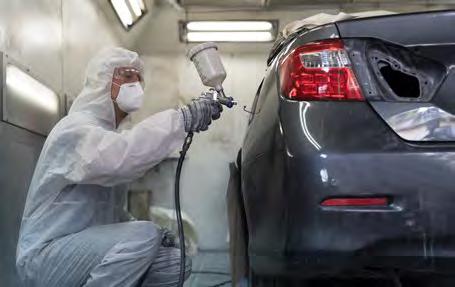
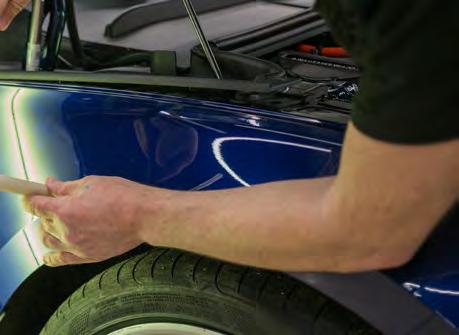
The shop’s 4.8-star Google rating reflects their commitment to quality. Customers consistently praise the team’s professionalism, attention to detail, and ability to get the job done right the first time. In an industry where trust is paramount, Elmwood Auto Body’s reputation speaks for itself.
After an accident, one of the most important decisions a car owner can make is choosing the right auto body shop. Not all repair shops are created equal, and settling for a shop without the right expertise, tools, or track record can result in subpar repairs that compromise both the appearance and safety of the vehicle.
Elmwood Auto Body goes above and beyond by using the latest equipment and techniques, ensuring that repairs are done to the highest possible standards. This not only preserves the vehicle’s resale value but also ensures that critical safety systems—such as airbags, crumple zones, and frame alignments—function correctly in the event of another accident.
With over five decades of family-owned service behind them, the L’Archevesque family understands the importance of community trust. Their commitment to quality is reflected in everything they do, from the customer service provided at their dealership to the precise and careful work done at Elmwood Auto Body. A 4.8 Google score isn’t easy to come by in the competitive auto repair industry, but it is wellearned through their dedication to customer satisfaction.
Whether you’ve been in a major accident or just need some minor cosmetic work, bringing your car to a reputable, well-equipped shop like Elmwood Auto Body can make all the difference. It’s more than just fixing a car—it’s about ensuring peace of mind for drivers and passengers alike.
When it comes to auto body repair, the L’Archevesque family’s Elmwood Auto Body is a name you can trust.

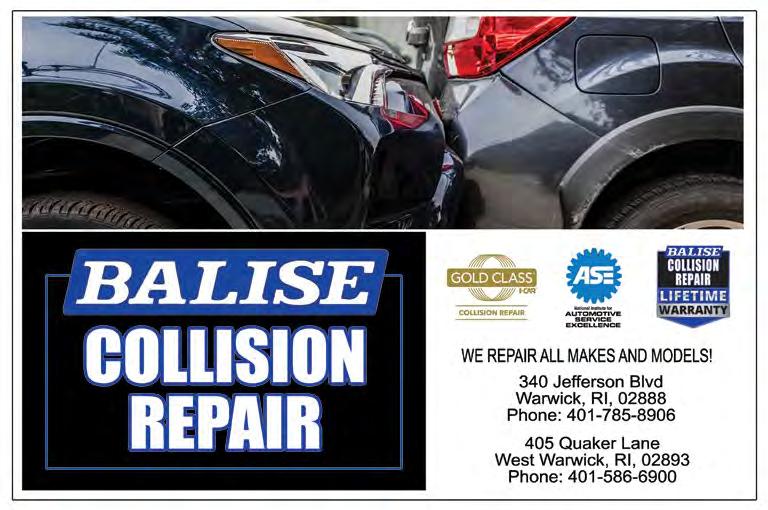





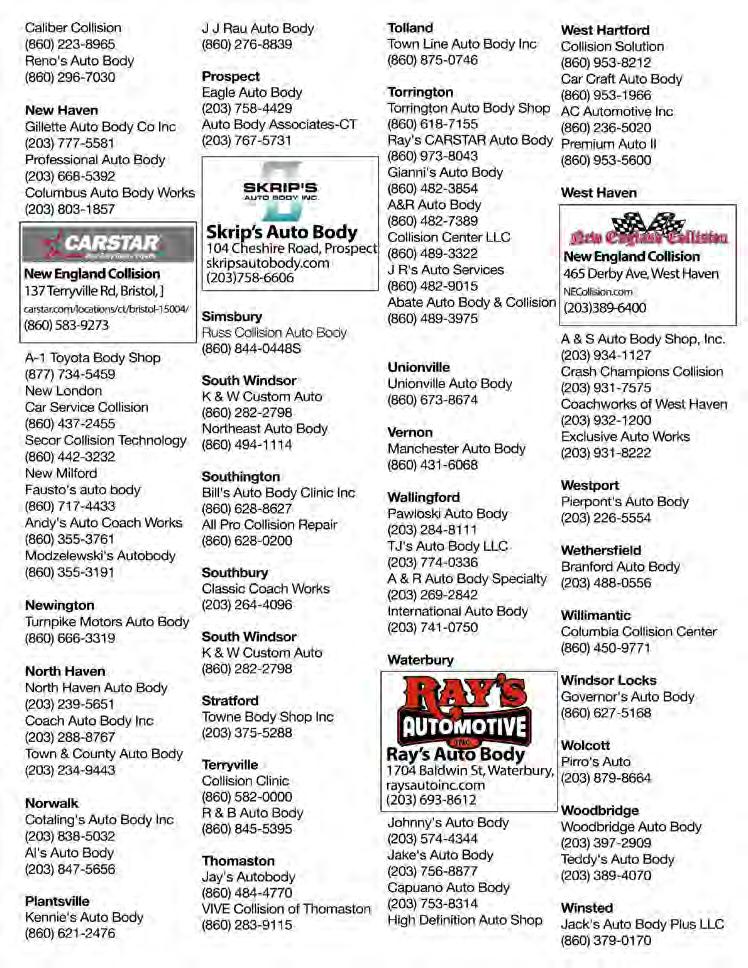

For classic car enthusiasts, owning a piece of automotive history is more than just owning a vehicle—it’s an investment and often a passion project.
However, insuring a classic car is a process that differs significantly from insuring a regular vehicle. Classic car insurance requires specialized knowledge, coverage options, and valuation methods to ensure that the car is adequately protected.
Before diving into the specifics of insurance, it’s important to define what constitutes a classic car. While definitions may vary between insurers, a classic car is generally considered to be a vehicle that is at least 20 years old, maintained in good condition, and often used primarily for pleasure rather than daily driving. Some insurers may have specific age requirements, such as 25 or 30 years, to qualify for classic car insurance.
Additionally, other categories like antique cars (vehicles over 45 years old) and collector cars (modern, limitededition vehicles) may also fall under specialized insurance policies. It’s crucial to check with your insurer to understand how they classify your car and whether it qualifies for classic or collector car insurance.
Classic car insurance differs from standard auto insurance in several key ways, primarily in the areas of coverage, valuation, and usage restrictions.
1 Agreed Value vs. Actual Cash Value: One of the most significant differences between classic car insurance and standard auto insurance is how the vehicle’s value is determined. In standard insurance policies, vehicles are typically insured based on actual cash value, which accounts for depreciation over time. This can result in a significantly lower payout in the event of a total loss.
Classic cars, however, are often insured based on an agreed value policy. In this arrangement, the car owner and insurer agree on a set value for the vehicle at the time the policy is written. If the car is stolen or totaled, the insurer
pays out the agreed-upon value, which takes into account the car’s rarity, condition, and market value. This avoids depreciation and ensures that the car’s worth is accurately reflected in the policy.
2 Usage Restrictions: Classic car insurance policies often come with restrictions on how and when the car can be used. Since these vehicles are considered more valuable and often fragile, insurers typically require them to be used for special occasions, such as car shows, parades, and occasional weekend driving. Daily use is generally




not allowed under classic car policies. Many insurers even set an annual mileage limit, often ranging from 2,500 to 5,000 miles per year.
This restricted usage helps keep premiums lower, as the risk of accidents and wear-and-tear is reduced. However, owners who wish to drive their classic cars more frequently may need to negotiate their policy or seek out insurers with more flexible usage terms.
3 Storage Requirements: Many classic car insurers require that the vehicle be stored in a secure, enclosed garage when not in use. This is to protect the vehicle from environmental damage, theft, or vandalism. Some insurers may even offer discounted rates if the car is stored in a climate-controlled facility, as this further reduces the risk of damage to the vehicle.
When insuring a classic car, owners have several coverage options to choose from, many of which go beyond what is typically offered in a standard auto insurance policy.
1. Liability Coverage: Like all vehicles, classic cars must be insured for liability in case the owner causes damage to another vehicle or person while driving. Classic car insurance typically includes the same liability coverage found in standard policies, though it may be adjusted to reflect the limited use of the vehicle.
2. Comprehensive and Collision Coverage: Comprehensive coverage protects against damage caused by events such as theft, fire, vandalism, or natural disasters. Collision coverage protects against damage resulting from an accident with another vehicle or object. Both are essential for classic cars, as repairs can be costly and replacement parts may be rare or hard to find.
3. Agreed Value Coverage: As mentioned earlier, agreed value coverage is the most important aspect of classic car insurance. This ensures that, in the event of a total loss, the owner will receive the full, agreed-upon value of the car, rather than a depreciated amount. It is vital for owners to ensure that the agreed value is updated periodically to reflect changes in the market value of the vehicle.
4. Spare Parts Coverage: Classic car owners often invest in spare parts for their vehicles, as replacements can be difficult to find. Some classic car insurance policies offer coverage for spare parts, which can be particularly useful for owners who keep parts on hand for future repairs or restorations.
5. Roadside Assistance: While roadside assistance is a common feature in standard insurance policies, classic car owners may need specialized assistance that understands the unique mechanics of older vehicles. Many classic car insurers offer tailored roadside assistance programs, which can include flatbed towing (to prevent damage), lockout
services, and help with finding specialized mechanics.
6. Restoration Coverage: Some policies also offer coverage for cars undergoing restoration. This ensures that if something happens to the car while it’s being restored, the owner will be compensated for the value of the vehicle, including the cost of the restoration work completed up to that point.
Several factors can influence the cost of classic car insurance, just as with standard auto insurance. However, there are some considerations unique to classic cars:
1. Vehicle Condition: The condition of the classic car plays a significant role in determining the premium. Wellmaintained, fully restored vehicles may cost more to insure due to their higher agreed value, but they may also be eligible for discounts if stored in secure or climatecontrolled facilities.
2. Age of the Driver: Insurance companies often offer lower rates to older, more experienced drivers. This is especially important for classic car owners, as younger drivers are considered higher risk, which could lead to higher premiums.
3. Location: The location where the car is kept and driven can also impact premiums. Cars stored in areas with higher crime rates or prone to natural disasters may cost more to insure.
4. Mileage: Limited mileage helps keep premiums low. Owners who drive their classic cars infrequently will generally pay less for insurance, as the risk of damage or accidents is reduced.
Insuring a classic car requires careful consideration and research. Owners should compare policies from multiple insurers and ask about coverage specifics, including the agreed value process, mileage restrictions, and any potential discounts. It’s also important to periodically review and update the policy to reflect changes in the car’s value and the owner’s usage.
Specialized insurers such as Hagerty, Grundy, and American Collectors are known for their expertise in classic car insurance and may offer more tailored options than general auto insurers.
Classic car insurance is not just about protecting a vehicle; it’s about safeguarding a valuable asset that often holds sentimental and historical significance. By understanding the differences between standard and classic car insurance, enthusiasts can ensure that their prized vehicles are wellprotected, whether they’re kept in a garage or on display at a local car show. Proper coverage provides peace of mind, allowing owners to enjoy their classic cars for years to come.
As the temperatures drop and winter approaches in the Northeast, particularly in Rhode Island, Massachusetts, and Connecticut, preparing your vehicle for the harsh conditions becomes essential.
Winter brings its own set of challenges for cars, and proper servicing can make the difference between a smooth, safe season and unexpected breakdowns or accidents. Here’s why scheduling that pre-winter service is so important.
Cold weather is notorious for draining car batteries. A weak battery might get you through summer, but in freezing temperatures, it could leave you stranded. Servicing your vehicle before winter allows a technician to check the battery’s strength and replace it if necessary, avoiding the frustration of a car that won’t start on a frigid morning.
Winter roads in New England can be treacherous, with ice, snow, and sleet creating hazardous driving conditions. Ensuring that your tires have adequate tread is crucial for maintaining traction. If your tires are worn, it’s time to replace them, and winter tires are an excellent option for added grip. Even if you have all-season tires, they should be inspected for wear and properly inflated to handle the cold.

Your braking system is your first line of defense on slippery roads. Have your brakes inspected and serviced to ensure they are in top condition. Modern vehicles come equipped with anti-lock brakes (ABS) and other safety features that help prevent skidding, but these systems need to be properly maintained to work effectively in winter.
Winter temperatures can wreak havoc on your car’s fluids, from engine oil to windshield washer fluid. Make sure your oil is changed and appropriate for cold weather, as thicker oils can make it harder for the engine to function efficiently. Antifreeze is critical to prevent the engine from freezing, so it’s essential to top off or replace the coolant. Don’t forget to switch to winter-grade windshield washer fluid, which won’t freeze and will help keep your windshield clear of salt and snow.
Visibility is key to staying safe on the road, and worn-out


wipers won’t do you any favors in a snowstorm. Replacing your wipers before the snow hits ensures that you’ll have a clear view, no matter the weather. Opt for winter-specific wiper blades, which are designed to handle ice and snow better than standard ones.
6. Heating System
A fully functioning heating system isn’t just for comfort; it also plays a role in defrosting your windows and keeping them clear. During a winter service, technicians will ensure that your heater and defroster are in good working condition so that your car stays warm and safe to drive.
7. Road Salt Protection
The roads in New England are regularly treated with salt to melt snow and ice, but this salt can be highly corrosive to your car’s undercarriage. Part of your winter service should include inspecting for any rust and applying a protective coating to prevent further damage. This will
help extend the life of your vehicle and maintain its resale value.
Above all, servicing your car before winter gives you peace of mind. Knowing that your vehicle is prepared for the cold, icy months ahead reduces the stress of driving in challenging conditions. It ensures that your car is reliable, safe, and ready to handle whatever winter throws at it.
New England winter weather can be unpredictable and severe. Preparing your car through proper servicing is not just a recommendation—it’s a necessity. By addressing potential issues before they arise, you can help ensure your safety, extend your vehicle’s lifespan, and avoid costly repairs down the road. Don’t wait until the first snowstorm—call your authorized dealer to get your vehicle ready.

“ If your tires are worn, it’s time to replace them, and winter tires are an excellent option for added grip.”

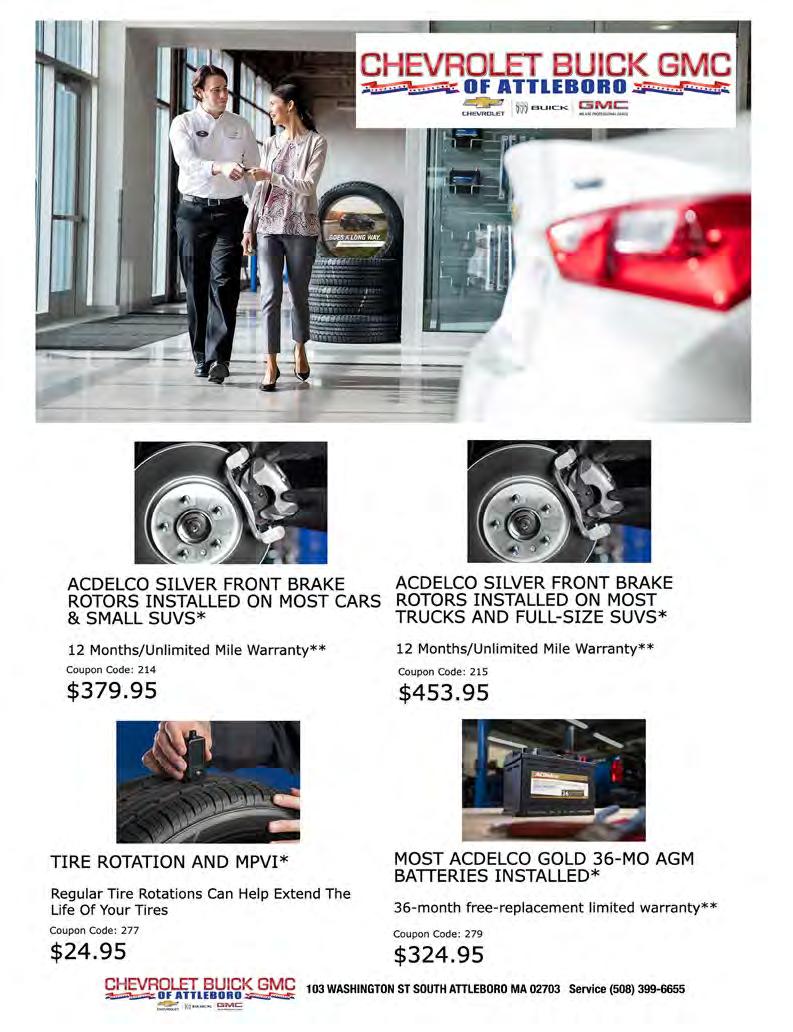
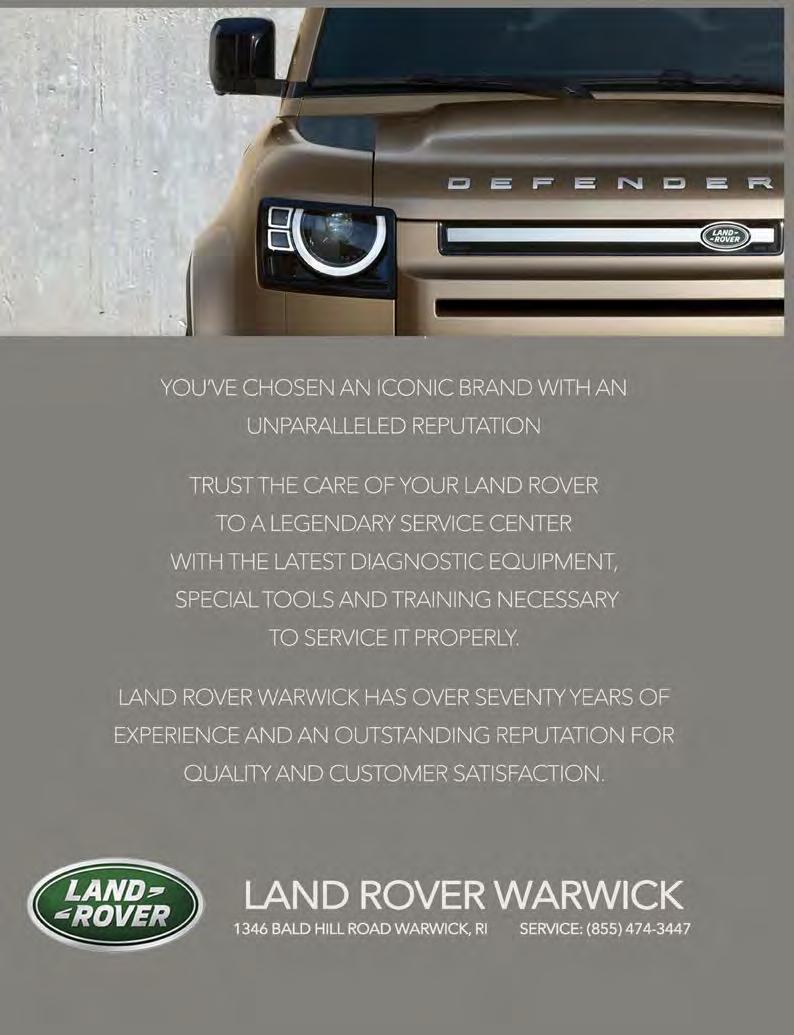



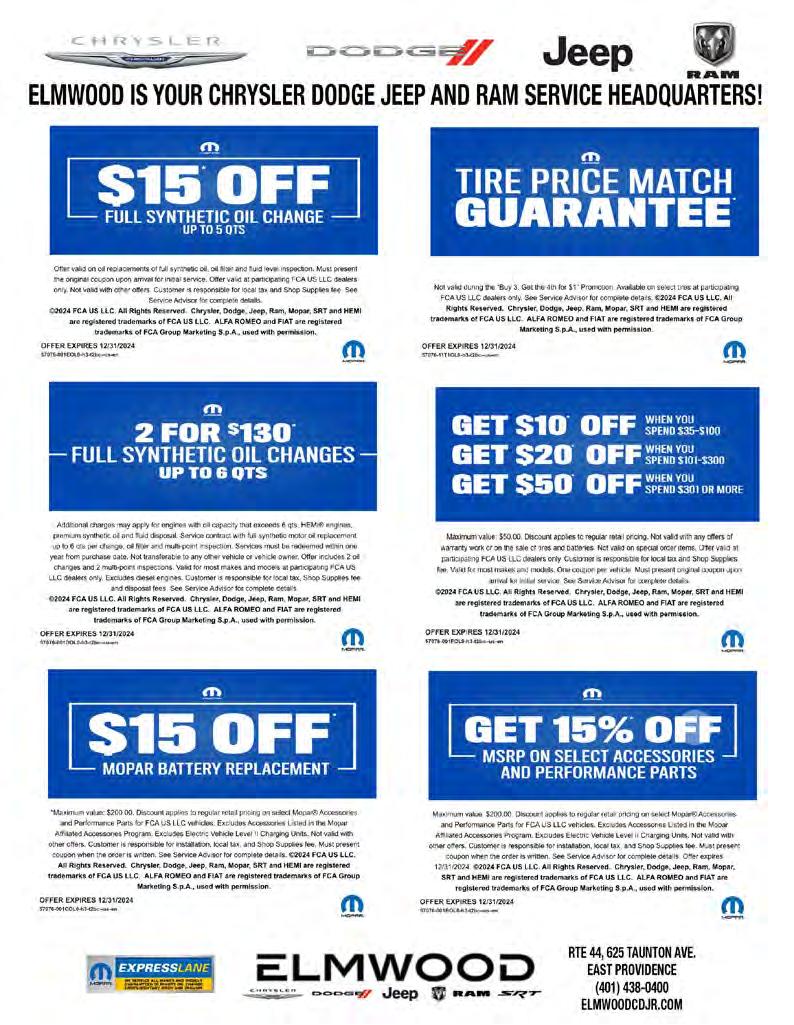
By Brianna Jeane
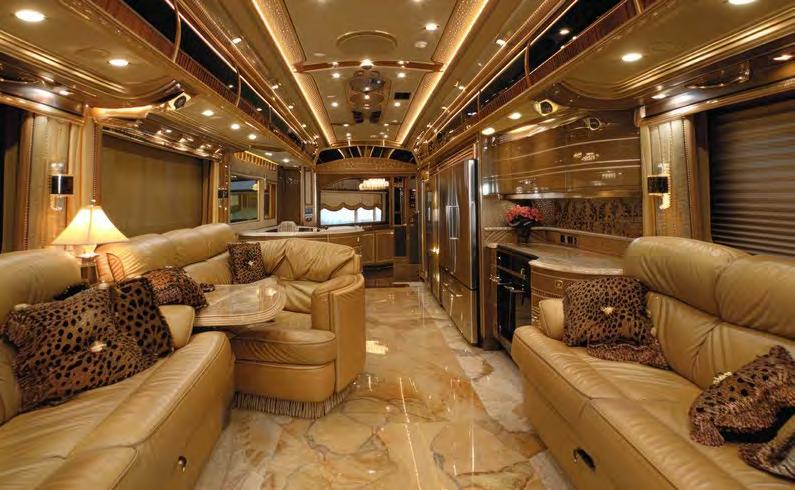
Ever wondered how living in a space the size of a walk-in closet could be liberating? Welcome to my world, where "living large" takes on a whole new meaning. You might think a tiny RV would cramp my style, but here’s the twist: I’ve discovered a paradox of comfort amidst chaos. It’s not just about fitting into a small space; it’s about thriving within it.
Forget spacious living rooms and expansive kitchens. My RV has taught me that less really can be more—if you have the right attitude. The secret isn’t just in clever storage solutions; it’s in embracing the quirky challenges that come with this lifestyle. Buckle up for some unfiltered lessons from the front lines of RV dwelling.
Adjusting to limited space in an RV was like a twisted game of Tetris. Essentials had to fit somehow, but the definition of “essential” got really strict, really fast. Gone were the days of sprawling kitchen gadgets and endless wardrobe choices. Essentials like pots, pans, and shoes? Sure, they made the cut. But the bread maker and extra throw pillows? Not so much.
Hacking IKEA storage ideas and mounting things on walls because who knew hooks were the answer to my sanity? Every day was a new game of “Where did I put that?” as I mastered the art of minimalism.
I soon realized that tiny living isn’t about sacrificing comfort but innovating in the face of impossibility. After all, if I can fit a kitchen table, bed, and an entire wardrobe into 200
square feet, I can conquer anything. Living large isn’t about space—it’s about smart living.
Living in an RV made me confront my attachment to “stuff.” Saying goodbye to clutter was like losing a bad habit. Do I miss my endless piles of “just-in-case” gadgets? Absolutely—because nothing says “I’ve traveled” like dust collectors. But RV life doesn’t care about sentimental junk. It demands essentials only. Prioritizing becomes a survival skill—what truly matters when


space is tight? Spoiler: it’s not the third set of mixing bowls. Decluttering was an emotional rollercoaster but ultimately freeing. I discovered that less is truly more when every item has a purpose.
My “must-haves” shrank to things I use daily or genuinely love. The rest? Donated or dumped. The emotional impact? It’s liberating to know I’ll never again search for my keys in a sea of junk. So, here’s to minimalist living—where the only thing I’m “missing” is the agony of overstuffed closets and the chaos of consumerism.
Cooking in an RV kitchen is like a reality TV challenge, minus the cameras and dramatic music. Adjusting to a tiny setup meant getting creative—meal planning became a strategic operation, and every ingredient had to earn its keep.
I’ve mastered chopping vegetables on a cutting board balanced over the sink. I’ve also discovered the joy of multifunctional tools—my one pan now doubles as a skillet, a baking dish, and, occasionally, a fruit bowl. Simple, onepot recipes are now my best friends. Forget gourmet; it’s all about what fits on my tiny stovetop.
Let’s just say smoke alarms work great. But there’s a joy in this simplicity, in turning chaos into creativity. Cooking in my RV isn’t about mastering cuisine; it’s about embracing the challenge of making something delicious, even if it means getting a little scrappy.
Entertaining in an RV is a crash course in making “cozy”

sound appealing. Hosting friends in a space barely bigger than a minivan requires creativity—and a good sense of humor. Fitting friends and family into this small space means getting creative. We trade dining rooms for campfires and sofas for folding chairs. I’ve learned the art of outdoor gatherings, where the open sky becomes the ceiling and the ground our dining table.
It’s BYOB and BYOE (bring your own everything). Surprisingly, these constraints create unique social bonds. The RV community thrives on shared experiences, from campfire stories to communal potlucks. There’s a sense of trust that’s rare in traditional neighborhoods. We bond over our love of adventure and our ability to laugh in cramped quarters.
It’s not about fancy dinner parties; it’s about genuine connection. Who needs a sprawling living room when your “social circle” extends across campsites nationwide? The best social life comes with a side of s’mores and limited elbow room.
Living in an RV means becoming a jack-of-all-trades overnight. I’ve faced unexpected breakdowns that made my heart skip a beat—like the time my engine quit on a mountain pass or the leak that turned my bathroom into a slip ‘n slide. I’ve learned to keep a toolkit handy and my sense of humor closer. Quick repairs are my specialty now, and I’ve developed a sixth sense for spotting potential burglars—it turns out nothing deters them like a yappy dog, strategically placed tools, and a strategically placed “Beware of Owner” sign.
Each mishap has its lessons: how to patch a flat, troubleshoot a faulty generator, and navigate roadside repairs like a pro. Embracing these challenges is part of the RV lifestyle, turning every setback into a story worth sharing. The open road is full of surprises, and I’ve learned to roll with the punches.
Embracing minimalism in an RV reshaped my mental landscape. I had to ditch the clutter and embrace simplicity. This shift wasn’t just physical; it was emotional. Less stuff meant less stress, and my mental well-being improved as my space shrank.
The benefit? A clear mind in a tiny home. I now prioritize what truly matters, finding solace in simplicity. Coping with RV life’s highs and lows involves regular decluttering and maintaining a positive outlook. Emotional adjustments included learning to relinquish sentimental items and finding contentment in the essentials.

Sure, there are moments of nostalgia for my old clutter, but I’ve discovered that comfort comes from within. The RV lifestyle taught me that minimalism isn’t about what you have but how you feel with less.
As a photographer and travel writer, living in an RV keeps me inspired—and keeps my bank account just above empty. I earn a living snapping photos of breathtaking landscapes and writing stories that capture the essence of life on the road.

Earning a living on the road involves juggling freelance gigs and photo sales, all while navigating Wi-Fi deserts. Thanks to Musk’s Starlink WiFi, I’m no longer driving around in circles, waving my laptop in the air, hoping for a signal, but it requires some creative yoga poses. But the freedom to chase the perfect shot and write from wherever I park is priceless.
My office view changes daily, from mountain peaks to coastal sunsets. I’ve learned to hustle hard, pitching stories between campsites and selling prints out of my tiny home. It’s not always easy, but it’s a dream job with a side of adventure— and who wouldn’t want that?
Thinking about RV living? Just go for it— clutter, quirks, and all. Sure, it’s a trial-and-error adventure where you’ll master tiny kitchens and dodge Wi-Fi black holes. But every misstep turns into a story worth sharing. Embrace the chaos, laugh at the mishaps, and revel in the freedom of the open road. Your RV might be small, but your experiences will be larger than life. So, pack up, hit the road, and let the wild ride of RV life begin. You’ll be surprised how much you’ll love the chaos.
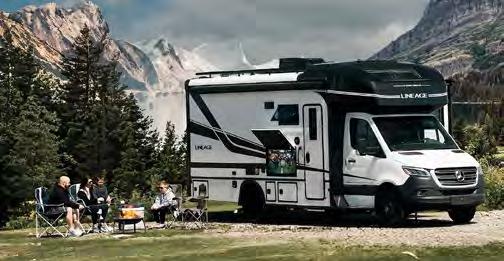
Life on the road in a Class C motorhome like the Grand Design Lineage Series-M 25FW is a blend of freedom and practicality. For those unfamiliar with the different classes of motorhomes, it helps to understand where the Class C sits in the lineup. If Class A motorhomes are the penthouses on wheels—massive, luxurious, and demanding a certain commitment—Class Cs are the upscale apartments. They offer a strong balance between comfort and drivability, without the intimidating size of a Class A. And compared to the nimble but often cramped Class B camper vans, Class Cs like the 25FW deliver more space without sacrificing too much on the ease of driving.
Class A motorhomes are the giants of the road, often stretching up to 45 feet long and loaded with amenities that can make them feel like rolling luxury suites. However, the size and weight of a Class A make them less maneuverable, which can be a drawback for anyone looking to explore more than just the open highways. Parking in smaller campsites or navigating through tight turns can be a nerve-wracking experience in a Class A. That's where a Class C like the Lineage 25FW comes into play.
At 25 feet 11 inches, the 25FW is big enough to offer significant living space, yet compact enough to take on a range of driving scenarios. Whether you’re cruising down a coastal highway or weaving through a national park, the 25FW’s MercedesBenz Sprinter 4500 chassis provides a driving experience that’s more akin to a large SUV than a bus. The Sprinter platform is known for its reliability and ease of handling, which makes it an ideal choice for a motorhome. It's powered by a 208-hp four-cylinder turbodiesel engine, paired with a 9G-Tronic automatic transmission, which offers smooth shifts and enough torque to handle the weight of the motorhome while still delivering respectable fuel efficiency.
for a reason. It’s not just about reliability; it’s also about the comfort and confidence it inspires behind the wheel. Mercedes-Benz has engineered the Sprinter with a focus on ergonomics and ease of use, which is a big deal when you're logging long miles across varied terrain. The driver’s seat is elevated, providing a commanding view of the road ahead, and the controls are intuitive, making it easier for drivers to keep their focus where it belongs—on the road.
Driving a motorhome, even one based on a Sprinter, isn’t the same as driving a regular vehicle. The 25FW has a significant presence on the road, but thanks to the engineering from both Mercedes-Benz and Grand Design, it remains manageable. This is where the distinction between Class C and other classes becomes apparent. The shorter wheelbase and overall length of the 25FW make it easier to handle compared to a Class A, particularly when you’re navigating through tighter spaces like gas stations or campgrounds.
For many RVers, the Class C represents a sweet spot: big enough to offer real comfort on the road but small enough to

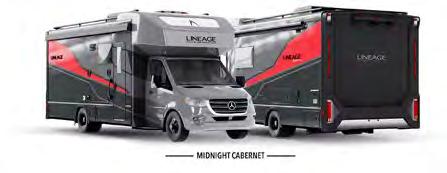

be maneuverable in a variety of settings. The 25FW, with its Sprinter 4500 chassis, is particularly well-suited to those who want a bit more versatility without giving up the amenities that make life on the road enjoyable. The full-wall slideout, for example, opens up the living space, making it feel less like a confined space and more like a compact apartment. The king-size bed is another luxury you wouldn’t expect in a motorhome of this size, making the 25FW an appealing option for couples or small families who want to travel without sacrificing comfort.
One of the standout features of the Lineage 25FW is its adaptability. It’s designed to be comfortable whether you’re plugged into shore power at a campground or boondocking in a more remote location. The standard 3,600-watt propane-powered generator provides ample power when you're off the grid, and the basic solar system ensures that you can keep essential systems running without constantly relying on the generator. For those who plan to spend extended time off-grid, the optional solar upgrade package is worth considering.

This package replaces the generator with an additional lithium-ion battery and a larger solar panel array, providing more autonomy and reducing the need for fuel.
Compared to a Class B camper van, which is essentially a converted van, the 25FW offers far more in terms of space and amenities. Class B vans are great for quick getaways or solo travelers who prioritize mobility over comfort. They’re easier to park and can often be used as a daily driver, but they lack the space that makes extended trips comfortable. In contrast, the 25FW provides a true home-on-wheels experience, with enough room to move around, cook a proper meal, and sleep comfortably. The larger bathroom, complete with a lighted shower and SeaDek shower pad, adds to the comfort, making it feel more like a proper home than a converted van.
The living space in the 25FW is thoughtfully designed, with a focus on functionality and comfort. The absence of floor vents, for instance, not only improves the overall aesthetic but also makes cleaning easier—
an important consideration when you’re living on the road. The upgraded ducting system, which runs through the cabinets and sidewalls, ensures even heating and cooling throughout the cabin, eliminating the hot and cold spots that can make some RVs uncomfortable.
For families, the ability to bring everyone along on adventures is a major selling point. The king-size bed, combined with the over-cab bunk and the convertible dinette or theater seating, provides enough sleeping space for a small family. The design of the 25FW makes it possible to enjoy the great outdoors without feeling like you’re roughing it. The kitchen is equipped with a Smart Sink and matching appliance package, so you can cook real meals on the road, and the tilt-out drawer for the trash can, along with the slide-out drawer for pet dishes, adds to the convenience.
In the world of motorhomes, the Grand Design Lineage Series-M 25FW represents a thoughtful blend of innovation and practicality. It’s a motorhome that offers the comfort and amenities of a Class A in a more manageable package, with the added benefit of Mercedes-Benz engineering. Whether you're planning a cross-country trip or a weekend getaway, the 25FW has the features and build quality to make every mile enjoyable. And with more Lineage models on the horizon, Grand Design is clearly committed to expanding its footprint in the motorized RV market, offering options that cater to a wide range of RVers.



